#*washes self in holiest of water*
Text
[P A S T] The Devil’s Dance
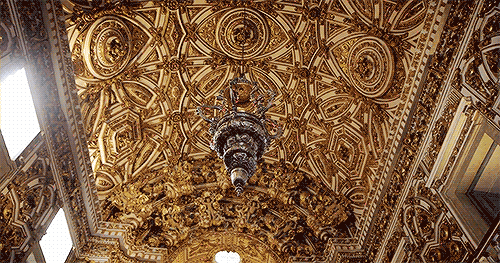
A solemnity hovered within the atmosphere of the sept as the ebony clad priests made their way down the only clear pathway leading toward the altar. The seven of them wandered so gracefully it looked as if they were hovering an inch or so from the ground but their majesty was hidden by the steep length of their robes. As they wandered haunting melodies fled their parting lips to bound off the high-rise ceiling winding into a dome above which left the large spans of glass overhead so as the sky could gaze down upon them.
This was the holiest of places among the Estate grounds and the most beautiful. Thick alabaster pillars held it strong while decorative vines encroached among its pallid surface speckling it with hard gashes of green and spotted with vibrant pops of color from the foliage. It was all too fitting that he died on the longest day of the year to further torment her and too on the day the flowers bloomed their brightest. The longest day meant they would take further care in their preparations of his body.
They soaked his corpse in lavender water for most of the morning, one by one the priests entered to comb back his air and shave his beard, trim his nails, and polish him till he glowed and smelled of the life his once lead. His clothes were washed thrice and ironed and mended for he was to be presented as he was.
Ottavia was there for all of it though at the behest of her grieving mother. If she were to close her eyes and cancel the prattle around her she could faintly hear the indistinct sobbing pouring down the corridors from her mother’s chamber. It was a sound that would linger within the estate hall for years after.
That poignant humming from the priests rattled against the iron scones and structures adorning the massive hall and for a time it seemed as if their music’s were intentional as to allow the building to drink their dread in. How foolish of her to delve into such juvenile train of thoughts.
Hadrian’s casket was just as extravagant as the halls he was to be settled within, how funny that most would claim a wooden box for their final bed yet there her father lay in riches and wealth just to have its interior sullied by his body dripping the vestiges of his earthly self. Perhaps there lie the irony. Shitting among our achievements.
With a single heave he was set before the entirety of the house and guests with a lurid grind against the wood till all that remained was its fading echo. The silence of death replaced the priests hum. On occasion a child would shuffle their footing and another would gently clear their throat.
Ottavia wasn’t entirely sure as to how loved her father was and the numbers would predict he was unconditionally adored but such concepts never issued with her.
She oft thought it was better to be hated than loved, one was certainly easier than the other. Adorning herself in black wasn’t uncommon, in fact she simply dressed herself in her habitual attire that no one cared or noticed---not even her mother who stood beside her gripping desperately to a wrinkled handkerchief which she so shakily held beneath her nose. On occasion her should shook mourning followed by an idle sidelong list so she could rest her head against her only daughter’s shoulder murmuring incoherencies.
The Ritualists gaze swooped skyward to pay mind to the firmament as a man she barely knew began to speak fondly of her father and on all the matters he reigned successful in. This man knew nothing of the things he pontificated, he spewed venom when he thought himself spreading appealing fragrances. The fighting urge to render the chapel asunder roiled through the length of her veins till it nestled deep within the cage of her chest daring to erupt till the weight of something warm drew her attention from the glass ceiling.
A hand settled to her shoulder succinctly followed by the gentle ebb of a bated breath.
“You could.” Sihdiel whispered, “And you should…. but not now. Not here.”
Ottavia’s gaze lingered long to her counterparts less than assuaging mien as if to challenge her authority---to a point she held none but with her hand set atop her mantle the aspect of her concern bled through the thickness of her attire and into her sinew.
“Stifling myself wasn’t always my strongest suit.” The Ritualist murmured briefly only to halt at her mother’s hiccuped yawping. The man pontificating of her father ceased his words and swooped an upturned palm toward the crowd till his thick and calloused fingers pointed toward Ottavia.
“---And now we welcome his heir—the Light of his days and core of his once beating heart. His daughter Ottavia.”
The searing of a hundred eyes all snapped to her uniformly all save for a single pair who opted to look away with a gentle snort, masking her sneer with the back of her hand.
“The people await.” Sihdiel chortled lowly.
“I shan’t disappoint. “
~-• -~
Mentions: @burdened-by-wrath
(I found this on my PC from June of 2016! Figured I’d post it to add it to the H&F list! That and it’s the aftermath to ET SANGUIS SANGUINEM PT. 1. PT.2 Will be posted soon!)
14 notes
·
View notes
Text
Coming Home

Set following the Fall of the Lich King, but before the Cataclysm
~*~
The mist around the Death Knight seemed to freeze to her plated armor, as Avehi stepped off the ship and onto the dock. It had been well over a year since she’d set hoof on the Azure Isles; last time she was here, she was saying goodbye to her friends before setting off to join with the Alliance. Much had changed since then. The war in Outland was won. The Draenei had earned their place in the Alliance.
She had died.
That fact cut through her like a chilled wind. She felt so empty now. A hollow husk of her former self.
After Outland, she joined a group of human Paladins - the Argent Dawn - in cleansing their ancestral home of Lordaeron of a foul presence. She’d never come across the undead before… but the Light would surely cleanse their blighted presence. The humans had done much for the Draenei people… a Vindicator like her was honor-bound to return the favor.
She lent her strength to their cause, and fought hard against the Scourge presence. But ultimately, this strange and foreign enemy proved to be her end. She fell by their fetid claws, left to be consumed by their endless, mindless, aberrant hordes. The last memory she had of her life was that terrifying image; being overrun. Being consumed. Then, only darkness.
It wouldn’t last; her eyes opened again some time later in the heart of the necropolis. She had been robbed of her peaceful afterlife. Denied the glory of joining with the Light. No… instead she became a slave to the very darkness that had taken her life - and so much more after that.
She shivered, shaking her head at the thought as she pressed onward. She pulled her dark hood over her head, further hiding her shame as she entered the vibrant and radiant halls of the Exodar. It was brighter than she remembered it; blindingly so. Her icy gaze narrowed as she progressed through the luminous halls. She could feel the radiance of the Naaru, dwelling within the very heart of the crashed vessel that had become their home. It was different now, though - before, a Naaru’s presence filled her with blissful calm. Now, she felt it like a fire, burning at her from the outside, rather than from within. It made her feel sick. Tired. Fatigued. Like she’d stood out in the heat too long. She was well out of her element here… she couldn’t stay.
Why had she even returned at all?
Rising as one of the Scourge’s Death Knights was surreal. She remembered her past, yet at the time it didn’t matter. All that mattered to her for a time was destroying the living - bringing down the Scarlet Crusade which threatened her Master - the Lich King - and his dark forces. She adapted well to combat, even in this new form. Her Vindicator training already taught her how to tap into power beyond the physical; though now, rather than calling on the Light, she called on something much more abhorrent. She was deadly on the battlefield, cutting down Scarlet after Scarlet in a vicious slaughtering. She found herself enjoying the carnage, reveling in the bloodshed. This was her purpose now, and she embraced it fully.
For a time.
She departed the Exodar as quickly as she’d arrived, barely making it down the ramp before she turned back. It was too much… physically, and emotionally. She remembered it with such fondness; now, it only filled her with dread. The darkness within her could not abide so close to such holiness. It hurt her form. It hurt her soul. She hung her hooded head in immeasurable sorrow as she emerged from the ship, back out into the misty pines of Azuremyst. She could feel onlookers gazing at her - she must’ve stuck out like a sore thumb to them in such a place. Her chilling gaze caught sight of a fisherman; he turned from her quickly and hastily without a word. Another glance, and she beheld a woman and her child. The woman gripped her youngling closer, pulling him along expediently away from Avehi. She couldn’t imagine they knew what she was… only acted on the fear of uncertainty. If only they knew…
The Scourge’s Champion.
With the Scarlet Crusade routed, and the Plaguelands claimed for her dark Master, she joined her brothers and sisters in undeath as they set their sights on their next target - Light’s Hope Chapel. The memory of that place resonated deeper with her than previous memories. It was jarring to see such a hallowed place again… from the other side of the war which raged there. Comrades she’d come to know from the Argent Dawn now stood before her, weapons drawn in defense of their holiest of landmarks. She stood in opposition of them - humans, dwarves, elves… people she’d considered friends, in life. It shocked her to her core to see them glaring her way. Looking at her as if she were their hated enemy… because she was now. The viciousness and ruthlessness with which she’d conquered the Scarlet Crusade left her; how could she raise her weapon to her friends in the Argent Dawn? Her eyes had opened now, and she realized what she was. As the forces clashed, she defended herself… but did nothing else to antagonize or bring harm to her Argent friends. They lost that battle… but she’d won something much more important. She remembered who she was in life. What she was in life. Her goals, her ambitions… her purpose renewed. She laid down her arms with other Death Knights who had had similar revelations about themselves. She joined with the newly founded Ebon Blade, and swore vengeance on the dark Master who had taken everything from her.
She couldn’t let that happen to anyone else.
Her eyes narrowed as they settled on another Draenei - a shamanism practitioner, by the looks of him. She set aside her discomfort for the moment, and stopped him on the path. Perhaps he could help her find who she had come looking for here…
“You, Brother.” she said shortly - voice distorted. “You are a shaman?”
“--Ah, uhh…” The Draenei froze in place, scared and confused. “Y-Yes…”
“Do you know a fellow shaman called Mierne?” Avehi asked.
“M-Mierne? I know of her, yeah… they say she lives along the eastern coast of Bloodmyst.” he replied, timidly. “Why?”
Avehi didn’t reply; she had learned what she needed from him. Without another word, she brushed past him, and headed towards the northern isle. Azuremyst was populated by her people, but Bloodmyst had only one settlement. It was much more hostile up on the northern isle; between the infected, agitated wildlife and the invasive and relentless Naga, it was far less hospitable than the relatively tranquil Azuremyst. Strangely, such a place seemed well-suited for Mierne. She’d never been the sort to conform to comforts. She carved her own path. Avehi remembered meeting her years ago in Zangarmarsh. Despite the Draenei settling in Telredor, Mierne had set up her own place to live out among the Krokul - the Broken. The opinions of her peers didn’t matter to her. She did what was needed, and helped those who weren’t able to help themselves. It had impressed Avehi so, and led to a firm friendship between the two of them.
That friendship was why Avehi had returned to this place. If anyone could understand her as she was now, it was Mierne.
~*~
The shaman sat on a cliff overlooking the sea. She had set up her crude, but functional hut hidden in the woods on the southwest side of Bloodmist. Despite her people’s best efforts, the wildlife was still deeply affected by the Exodar’s crash. Mierne has made it her own personal mission to help stabilize and heal the land with the spiritual gifts the elements granted her. It was an uphill battle, but bit by bit, progress was being made.
It wasn’t easy living, but it was her way. Mierne has always preferred solitude, preferring the comforts of the natural world to the metallic and crystalline structures of the Exodar. She would visit on occasion, to give reports and personal visits to a friend, but her heart was wild. Untamed.
As she sat in quiet meditation, her tail twitched as one of her alarm totems was set off. Someone was nearby. She opened her eyes and pressed her hand to the ground. It wasn’t an animal… it didn’t even have a pulse. Arcs of electricity sparked over her form as she stood. However, she didn’t remain standing for long, before her form shifted to that of a slightly transparent wolf.
She took off into the woods, towards the Forsaken that dared intrude on this land.
~*~
The Naga’s blood began to gurgle in their hollow throat, as Avehi pulled her blade from it. She kicked the last of the slimy fish-beings over, before stepping up to the water to cleanse their viscous blood from her runeblade. She frowned at the weapon - it wasn’t one she used in life. No, in life, she used a blessed crystalline hammer… a vessel of the Light. She scowled as the runes along the blade’s surface illuminated - the blood she’d shed excited the unholy sigils, coaxing them to life with satisfied hissing whispers.
She hated this blade. She wondered why she even carried it still. It was a gift once. A gift from her Dark Master. But now, it felt more like a curse… the blade shared in her hunger for blood. A hunger she had to sate time after time. These Naga sufficed for now, but the blade would hunger again soon. She grew tired of feeding it. Tired of sustaining such a dark relic through her carnage. She suddenly felt sickened by the very sight of it - the runes pulsing, like low, silent laughter. She hated this blade!
CRACK!
In an angered fit, she gripped the blade’s tip and hilt, and brought it down over her plated knee. There was an ethereal scream as the runes shattered! The blade itself fractured, cracks sprawling like veins from the impact site. She growled, baring her teeth at the inanimate, broken weapon. With a heave, she tossed it into the sea to be consumed by the waves.
This visit was to look forward. Not back.
Her hand oozed with dark blood - a parting gift from the blade. He grunted as she knelt down, to dip her hand in the water and let the waves wash the blood away. A sigh… what did it matter? Discarding the blade didn’t change what she was. What she’d become. She felt better… but only for a moment. Now, she felt alone. Lost. She sat back from her kneel, simply sitting on the beach as the waves crept up her legs… then receded. Again, in steady rhythm. She closed her eyes, and listened to the waves break over her hooves and plated legs. It was soothing, helping her calm her troubled, racing mind.
Her search could wait a moment or two.
Mierne’s ears pinned back as she heard a scream. It didn’t come from any living creature she knew. It wasn’t natural. She stifled a growl as she silently made her way onto the beach, surveying the damage. Naga bodies lay dead, littering the shoreline with their blood. The wolf paid them little mind. They were a nuisance, like the murlocs, fine in small numbers, but left to multiply, they became invasive and a danger to everything around them.
She kept her guard up as she padded over to the one that had caused the carnage -the undead-. For a moment she wondered if it was still ‘living’ as it kneeled perfectly still in the water. Her instinct had been to attack and chase the creature from the isle, but if it was injured or near death.
She shifted into her natural form as she mentally called to the elements. Gathering storm clouds above them. She drew the silver hammer that had been strapped to her side.
“Two choices,” she spoke in common with a heavy Draenei accent, “You leave, or I put you at peace, once and for all.”
Avehi froze; she recognized that voice! Her search ended much earlier than she anticipated! Oh, how she wanted to spring up, and rush into her old friend’s arms… but given the tone of her voice, and the thundering clouds she’d conjured overhead, it was clear Mierne didn’t recognize Avehi.
How could she, anyway? Avehi looked down at herself - her dark, frayed, bloodstained Ebon Blade robes. The hood which covered her hair and obscured her horns… but deeper than her appearance, Avehi knew her aura had changed significantly - something a seer like Mierne would read easily enough. Even in that way, she was disguised, unfamiliar to her dear friend. It hurt to think how different she was now. She closed her eyes, and sighed.
“... I am not here seeking trouble.” she stated, in her native Draenic. “Nor peace.”
She stood slowly, as the water crashed over her lap one final time. Deliberately and calmly, she reached up and pulled her hood back as she turned to face Mierne. She stared at the shaman with icy blue eyes - screaming silently in pain and sorrow. If they could well up with tears, they might’ve in that moment… even if they’d only freeze to her face as a result. She frowned deeply, expression heavy with anguish. She wasn’t the jovial Vindicator she was in life - inside, or out. No wonder Mierne didn’t recognize her...
“I’m here seeking an old friend.”
Mierne’s snarl vanished as the undead filth removed its hood to show a familiar face. Her eyes widened, as though she were looking at a ghost. In a way, she was.
“...A… Avehi…” the name came out in almost a hush, unable to believe what her eyes as elemental senses fed her.
Her dear friend in the shape of an animated corpse. There was no mistaking the aura of undeath, the still, unbreathing chest, the lichfire blue eyes, the pale skin… there was no mistaking what she had become. A fate worse than death, some would say…
She dropped her hammer in the sand as she brought a hand up over her mouth as she found herself unable to do anything else but stare. Tears stung her eyes. Mierne had lost many dear friends over her long life, but losing Avehi had been one of the hardest deaths to swallow. She still hadn’t fully recovered…
“I…” she managed, swallowing down the lump in her throat, “...never thought I would see you again.”
She opened up her arms to the younger Draenei… now frozen in her youth… beckoning the Death Knight over like a mother would a lost child.
Her expressionless face found one - a shameful frown. Avehi watched Mierne’s reaction for only a second, before the shaman’s expression of stunned disbelief turned Avehi away. She clenched her fists, fighting back tears that wouldn’t come as she stared off to the side. Avehi hated what she’d become… and it showed in her inability to look her dear friend in the eye. Somehow she felt sick. She wanted to vomit. She wanted to scream. She wanted to run. A part of her wished she never come here, and revealed to Mierne what sort of abomination she’d become. Why? Why did she even bother coming? Now, it felt as if all she’d done was hurt her friend by revealing a horrible, horrible truth. Had she--
Avehi gasped, catching Mierne’s movements out of the corner of her eye. She looked back to the Shaman… who stood arms wide open to accept her. Avehi was stunned. It was a gesture she never would have expected, but it was one she desperately needed in that moment. She took a tentative step forward… then another… her lip trembled as if about to cry as she closed the distance between herself and her friend - her only friend.
“Mierne…” she whispered, stopping just before the Shaman. “Mierne… I’m sorry… I’m so sorry…”
She closed her eyes tightly as she threw her arms around Mierne, and tucked her chin over her shoulder. A hug… an embrace… it had been so long. Her body was cold and lifeless, but in that moment she felt a flicker of warmth as she reunited with Mierne. Like a child in the tender embrace of her mother…
“I’m so sorry… I never meant to worry you… or startle you...” she sobbed. “But I… had to see you again…”
“Shhh….” Mierne soothed her young friend.
Her arms held Avehi in a tight embrace. She’d managed to hold in her own sobs, but tears still rolled down her dirty cheeks. It pained her to see her friend like so, to feel how cold and lifeless her body had become. She felt her knees weaken, allowing herself to kneel down in the sand and pulling Avehi down with her. She didn’t release the embrace, as though she were trying to bring life back into her friend with warmth alone. Her heart ached? But she knew it was nothing compared to the suffering the Death Knight felt.
“Do not apologize,” she finally said, releasing the embrace slightly only to bring a hand through Avehi’s hair, “I am thankful you came to me… that you have returned home. I will always… ALWAYS… be there for you.”
She took in a deep breath, pushing back her own sorrow to better take care of her friend. She took Avehi by the shoulders and pushed her back slightly. Hands cupped her face and forced her to meet her gaze.
“I promise.”
Avehi played her part well; she hung lifelessly in Mierne’s arms as the two collapsed to a kneel. She only held on, clinging to the Shaman tightly as quiet whimpers escaped her. She remembered the last time she embraced Mierne like this, before leaving the Isles to join with the Alliance and see what Azeroth had to offer. The contrast between the memory of that embrace and this one now was stark… jarring… driving home for Avehi how much undeath had changed her. How she felt, how she sensed things, how disconnected it all seemed, while at the same time being such an overload…
‘What have I become…?’
For all the differences, Avehi felt something familiar in Mierne's arms. Something even death couldn't twist or distort… a calm comfort… the very comfort she came seeking. Mierne's words only made that calm comfort stronger. Her icy blue eyes peered into her dear friend’s. She nodded, offering a weak but genuine smile.
“Home…” her death-distorted voice echoed. “Mierne… thank you. I need… I need a home, now more than ever.”
She shook her head, brow furrowed as a frown replaced that weak smile once more. She looked away in shame again, teeth clenched.
“I've been… lost… for so long.” she murmured. “I never should have left you! I… I never should have…”
“You did what you had to do, Avehi,” Mierne comforted her friend, bringing a hand through her hair, “You made our people proud and died with honour, fighting a great evil.”
Mierne removed her helm from, revealing the mess of tangled braided hair beneath, and genuine features. She looked her friend over, now that the worst of the shock had worn off. Avehi had always been a beautiful Draenei, and even her obvious undeath couldn’t mar that. Sadly, not many would look past the pale features and lich blue eyes… Mierne knew how quickly their kind could be to outcast others.
“We do not always get to choose our path, my friend. This is the path you have been given. Many will not understand what you are, but death is part of life, even for the long lived. Do not allow anyone to tell you that you do not belong because of what you are. You will always have a home with me, whatever happens.”
Avehi wept - an unholy wailing, echoed and distorted by undeath. It rang out, hauntingly, eerily, along the coast and back through the misty woods of the Isles. She cried her cries devoid of tears against Mierne’s chest, tucked in her warm embrace. She had no words, yet the moaning cries spoke volumes of her anguish, fears… relief, and gratitude. Hardly the reunion she envisioned having with Mierne… but the elder Draenei always knew what to say and how to treat her. At her best… and now, at her worst. She was grateful for that, expressed in the moment only through tightening her arms around the shaman. She needed to hear that; to feel that acceptance of her in spite of her horrific new form - the husk of her deceased body breathed living once again by foul and unholy magic. The pain was intense, physically and emotionally, unlike anything Avehi had felt before. But there, in the arms of an old, dear friend… she felt a sense of calm. Relief. Peace.
She was home.
~*~
((Co-written with @kidcatgemini, the character Mierne belongs to her))
6 notes
·
View notes
Photo

❝ the BLOOD caked to his fingers does not wash with even the holiest of water . it is a part of him , as much as the DANGEROUS glint in his eyes and the brand of a life long passed pressed to freckled skin . he has BURNT the remnants of his old self to the ground , but the ash colors his skin a ghostly white , and he CHOKES on the smoke that billows into his lungs . THE NOOSE TIGHTENS AROUND HIS NECK . ❞
template credit .
#YEETS THIS HERE#im gonna go play overwatch now but pls#love my boy in the mean time#overwatch rp#overwatch roleplay#twd rp#the walking dead rp#world of warcraft rp#skyrim rp#marvel rp#witcher rp#jesse mccree roleplay
14 notes
·
View notes
Text
Strangers to Friends: Pushkar Mela
“It is said that travelling brings you close to the person you are travelling with therefore this trip started with a group of strangers and ended as friends.”

I was picked up from the Jaipur with others and we travelled from Jaipur to Ajmer taking highway NH 48 covering a distance of 135 km. We reached our hotel by afternoon and taking a few hours of rest we headed towards Pushkar which is about 16 km from Ajmer. On reaching Pushkar the vibe of the atmosphere was full of life and colour.
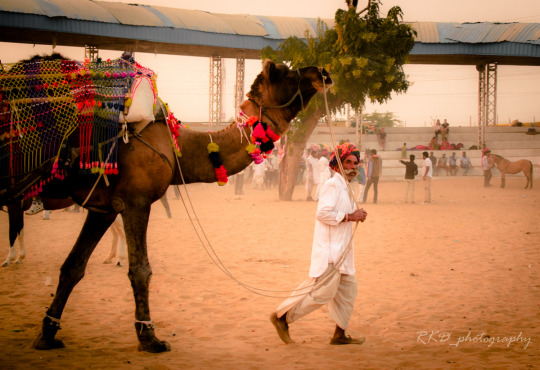
About Pushkar Mela (Pushkar Fair), also known as Pushkar camel fair, is an annual multi-day livestock fair and cultural festival with unique exhibitions and events such as dances, tug of war, camel races and others. The fair is celebrated during the month of Kartik Purnima. Apart from the fair, an enormous amount of Hindu devotee does come to visit Pushkar lake to wash away their sins by taking bath in the holy lake and take the blessing from one of the rarest Brahma temples in the world. During the Mela (fair) you get to eyewitness vibrant urban life of Rajasthan and free-spirited people wearing a colourful and traditional dress, turbans, bangles etc.


To reach grounds of the Mela (fair) you walk by gullies (alleys) which are full of shops, hotels, guesthouses, restaurants and cafes. These gullies are so crowded that sometimes you can even get lost but still it’s colourful, soothing and timeless. You will see shops of antiques, bangles, clothes, shoes, bags, jewellery, toys etc. Near the gate of Bharatpur Ghat of Pushkar Lake, there is a gully only with sweet shops I termed as sweet gully because at the entry of that gully only you will smell the aroma of sweetness in the air.


On reaching the grounds of the Mela, seeing the cattle fair the two things came to my mind was bizarre and chaotic but in a good way after walking and roaming in the sand and activities happening around made me feel it is much bigger than what I expected. Selling and buying of animals (camel and horses), food stalls, different competitions and dances you get to see. You can also enjoy camel safari rides through the sand dunes and if you do in the evening you get to see a beautiful sunset.


Pushkar lake is one of the most sacred sites for Hindu pilgrims and even considered equal status to the holy Ganga river, encircled by 500 temples and 52 ghats. According to Hindu Mythology, when Lord Brahma creator of the universe killed the demon Vajranabha Lotus petals from the hand of Lord Brahma fall and water spurted forming the sacred Pushkar Lake
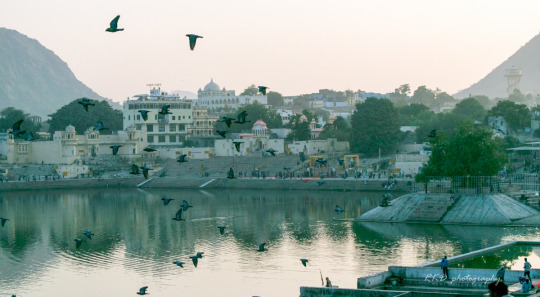
Spending evenings on the stairs of the Pushkar Lake is one of the beautiful and spiritual sites you will witness, music coming from all direction of prayer songs and bells from the temple, musical instruments played from the ghats, sadhus enchanting mantras and the aarti makes the surrounding energetic, pure and spiritual.



Visit this place in the evening during aarti time and spend some time by the ghats. Do remember not to walk by the ghats wearing shoes or chappals, else people or sadhus will shout at you for wearing.
Brahma Temple in Pushkar is one of the few and the major thriving temple of Lord Brahma, dedicated to the creator of the Universe. The vast entrance of the temples comes after the flight of long stairs and the architecture is full of canopy and pillars. once inside the temple, apart from the Brahma temple, there are small temples dedicated to other gods.

The temple remains closed between 1:30pm to 3pm. Photography from DSLR camera and the mobile camera is strictly prohibited if caught by the authorities you will be fined. You can keep your camera’s in the lockers of the flower shops near the temple and paying them by 100-150 rupees.
Savitri Temple is at the peak of the hill, it is a small temple and believe me on reaching the top you get to see the most mesmerising view of the whole Pushkar city (one should definitely come). There are two ways to reach the temple, one can either trek up to the hill trough stairs which is not hard and will take 45-50 minutes to reach or can take cable cars which takes 10 minutes to reach the temple.


The best time to go to the temple is early morning to see the sunrise behind the mountains. Don’t go in between 12pm to 2pm at that time temple remain closed.
Ajmer Sharif Dargah is one of the holiest and most sacred pilgrim places worshipped by devotees and followers irrespective of their religion, caste or faith. It is the resting place of a great Sufi Saint Moinuddin Chishti and is believed that person praying purely at Ajmer Dargah Sharif meets all his wishes

On entering through the huge door called as Buland Darwaza you will see the crowd of people at the courtyard rushing towards a single room to worship and present an offering to the tomb of Moinuddin Chishti, carved out of marble and gold plating on top. I found peace and tranquillity at this place and felt connected to my spiritual self. Do visit this place and it’s about 15 km from Pushkar.
Don’t enter Dargah bare head, one should cover his/her head either by rumal or chunni and if you don’t have you can get from the shops outside the Dargah. As the Place has massively crowded with people be aware and cautions from pickpocketers.
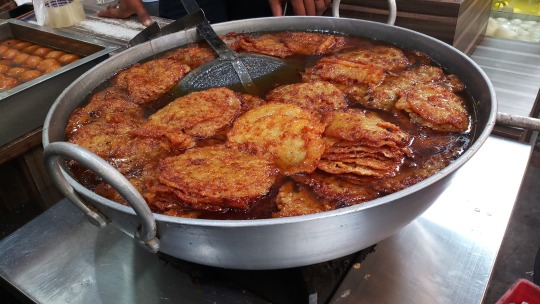

For foodies, it’s a paradise you will find a range of roadside and rooftop cafes and restaurants serving Indian, Chinese, Italian and Italian food from kachoris…samosas, malpua….raberi-jalebi, falafel, masala chai. Do try the delicious Rajasthani thali to experience the true flavour of Rajasthan.
After experiencing the chaos and madness of Pushkar Mela it was time to say goodbye and would like to thank EcoNomads (https://www.economads.in/) for organising such an amazing trip and opportunity to make new friends who at the start of this trip were strangers. I definitely recommend experiencing the Pushkar Mela once in life.
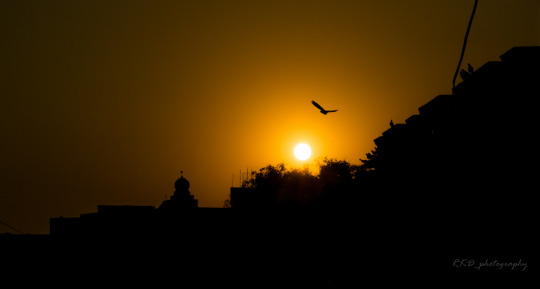



1 note
·
View note
Photo

#Reflection Looking back there may seem to be mistakes and sins we’ve committed we may never be forgiven for. Even if, somehow, one is absolved by others, the shame of having committed them may cause such intense guilt that it turns to self-hatred, of feeling unworthy in the eyes of others. Yet, in front of the eyes of our Heavenly Father, we were and always will be naked. Our nature is sin, whilst Gods’ is forgiveness. We cannot hide our misdeeds from Him; we can only be forgiven in confessing them. Only if we have the courage to trust in the mercy of our Lord, in admitting to our darkest wrongs, can we be made pure again. #Prayer Merciful Father, who sees all that dwells within the heart, please wash my body of its scarlet sins, so that I may become pure as snow. Take my hand, and lead it to the Riverbanks of Jordon, wherein I may cleanse all my trespassings within the Holiest of waters. Bathe me in your mercy, so that I may emerge pure as a lamb, forever thankful, and forever in your debt. Amen. https://www.instagram.com/p/CRYsn8RtxY3/?utm_medium=tumblr
0 notes
Text
🌜Night Prayer
Come now, and let us reason together, saith the LORD: though your sins be as scarlet, they shall be as white as snow; though they be red like crimson, they shall be as wool.
From: Isaiah 1:18
Inspiration
Looking back there may seem to be mistakes and sins we’ve committed we may never be forgiven for. Even if, somehow, one is absolved by others, the shame of having committed them may cause such intense guilt that it turns to self-hatred, of feeling unworthy in the eyes of others. Yet, in front of the eyes of our Heavenly Father, we were and always will be naked. Our nature is sin, whilst Gods’ is forgiveness. We cannot hide our misdeeds from Him; we can only be forgiven in confessing them. Only if we have the courage to trust in the mercy of our Lord, in admitting to our darkest wrongs, can we be made pure again.
Prayer
Merciful Father, who sees all that dwells within the heart, please wash my body of its scarlet sins, so that I may become pure as snow. Take my hand, and lead it to the Riverbanks of Jordon, wherein I may cleanse all my trespassings within the Holiest of waters. Bathe me in your mercy, so that I may emerge pure as a lamb, forever thankful, and forever in your debt. Amen.
0 notes
Text
Why do Hindus Worship the Tulsi Plant ?

Today, in-spite of the fact that the mankind has reached extreme heights in medicine, the entire medical fraternity world over acknowledges the traditional and herbal characteristics of Tulsi. The properties of Tulsi, which the world has acknowledged today was known to Indians since ages. There is a sanskrit saying, tulanaa naasti athaiva tulasi - which means "that which is incomparable (in its qualities) is the tulsi".
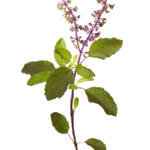
For Indians tulasi is one of the most sacred plants. In fact it is known to be the only thing used in worship, which, once used, can be washed and reused again and again in pooja - as it is regarded so self-purifying. Tulasi is a gentle female energy, a sweet little goddess, and should be treated like the queen she is – the queen of medicinal plants. For she is also a plant of power, a powerful lady, a friend, a physician and an ally. When you have Tulasi plants around, you are protected, and she will bring beauty, health, elegance and grace into your life. Wherever there is Tulasi
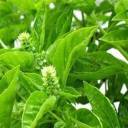
Mayi, there is pavitrata, purity in the environment, for she is a great purifier, both of the body and of the environment. If you plant nine or eleven Tulasi trees in your garden the air will be pure within a wide radius, and bacteria-free. She is one of those trees that possess divine qualities to invoke the descent of devatas, illumined beings, and increase the spiritual vibrations in the vicinity. The Tulasi plant is extremely sensitive and aware, and is able to register the vibrations around her. She loves to listen to the Vedas, all Sanskrit chanting, to hear the name of God in the form of a kirtan, and she is especially fond of ragas sung to the accompaniment of the tampura.
Stories pertaining to the Sacredness of Tulsi
The Devi Bhagavata Purana regards Tulsi as a manifestation of Goddess Lakshmi, the goddess of wealth and principal consort of Vishnu. Once upon a time, King Vrishadhvaja—a devotee of the god Shiva—banned worship of all other deities except for that of his patron god,Shiva. An agitated sun god Surya cursed him that he would be abandoned by Goddess Lakshmi. Upset, Shiva pursued Surya, who fled, finally seeking shelter with Vishnu. Vishnu informed the deities that years had passed since Vrishadhvaja lived on earth. Vrishadhvaja and his heir-son and family were all dead and his grandchildren—Dharmadhvaja and Kushadhvaja—were now worshiping goddess Lakshmi to gain her favor. Lakshmi rewarded their efforts by being born as their daughters Tulsi (literally "matchless") and Vedavati (Tulsi to Dharmadhvaja and Vedavati to Kushadhvaja, respectively). In time, Tulsi gave up all her royal comfort and went to Badrinath to perform penance to gain Lord Vishnu as her husband. Lord Brahma was pleased with her penance but told her that she would have to marry the demon Shankhachuda before she could marry Vishnu. Sudama, a part-incarnation of Krishna (an avatar of Vishnu) was born on earth as the demon (Shankhachuda) due to a curse. Shankhachuda, who also pleased Brahma with his penance, was granted the Vishnu-Kavacha (armour of Vishnu) and blessed him, that as long as his wife's chastity was retained and Vishnu-Kavacha was on his body, no one could slay him. Shankhachuda and Tulsi were soon married. Shankhachuda was filled with pride and terrorized the beings of the universe. To rescue the universe, Shiva challenged Shankhachuda to war, while Vishnu went to Tulsi to break her chastity. Vishnu assumed the form of Shankhachuda and compelled Tulsi to have coitus. With her chastity broken, Shankhachuda was killed and Sudama was freed of his curse. In the middle of their love-making, Tulsi recognized the impersonator. Vishnu appeared in his true form and urged Tulsi to abandon her earthly body and return to his celestial abode as Lakshmi, his wife. Tulsi's mortal remains decayed and became the Gandaki River, while her hair transformed into the sacred Tulasi plant.
Vishnu, the Lord of the Three Worlds, takes up abode in the village or the house where Tulasi is grown. In such a house no one suffers calamities like poverty, illness or separations from dear ones.
~Padmapurana, Uttarakhanda, 6-24-31-32
A Vaishnava legend relates Tulsi to the Samudra Manthana, the churning of the cosmic ocean by the gods and asuras (demons).
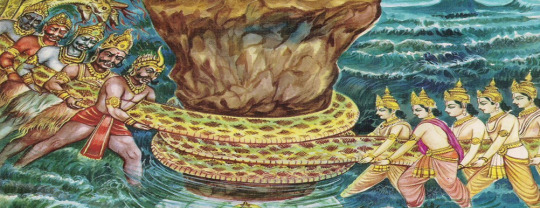
At the end of the churning, Dhanvantari rose from the ocean with Amrita (the elixir of immortality). Vishnu procured it for the gods, when the demons tried to steal it. Vishnu shed happy tears, the first of which fell in Amrita and formed Tulsi.

Lord Shiva and Goddess Laxmi
She also symbolizes Goddess Lakshmi, the consort of Lord Vishnu. Those who wish to be righteous and have a happy family life worship her. Goddess Tulsi was married to the Lord with all pomp and show as in any Indian wedding. This is because of another legend, which states that Lord Vishnu blessed her to be His consort.
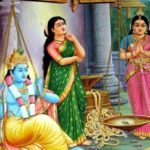
Weighing of Lord Krishna
According to another legend, Satyabhama once weighed Lord Krishna against all her legendary wealth. The scales did not balance till a single tulsi leaf was placed along with the wealth on the scale by Rukmini. Thus tulsi played a vital role in demonstrating to the world that even a small object offered with devotion means more to the Lord than all the wealth in the world. The tulasi leaf has great medicinal values and is used to cure various ailments in the human body.
Srimad-Bhagavatam 3.15.19 explains the special position of the Tulasi plant: “Although there are numerous flowering plants full of transcendental fragrance in the spiritual realm, they are aware that Tulasi is given special preference by the Lord, who garlands Himself with Tulasi leaves.”
In her form as a plant, Tulasi always stays at the Lord’s feet and around His neck. (Her leaves and flowers decorate His feet and are strung into garlands to be worn around His neck.) The Vedic scriptures say, “Krishna gives Himself to a devotee who offers Him merely a Tulasi leaf and a palmful of water.”
The wood of dead Tulasi plants is used to carve sacred beads devotees wear around their necks and use for chanting the Hare Krishna mantra. Tulasi is always grown at Krishna temples.
Worship
While tree worship is not uncommon in Hinduism, the Tulasi plant is regarded as the holiest of all plants. The Tulsi plant is regarded as a threshold point between heaven and earth. According to a traditional prayer, the creator-god Brahma resides in its branches, all Hindu pilgrimage centers are present in its roots, the Ganges flows through its roots, all deities in its stem and its leaves containing the Hindu scriptures - the Vedas in the upper part of its branches. Tulsi is often denoted as "the central sectarian symbol of Hinduism". The Vaishavas consider it as "a manifestation of god in the vegetable kingdom”.

The Tulsi plant is grown in or near almost every Hindu house, especially by Brahmins and Vaishnavas. Sacred places where they are grown are also known as Vrindavan (grove of Tulasi). Vrindavan is a raised cuboid stone or brick structure often in middle of the house's courtyard or in front of the house.
A person who waters and cares for the Tulsi daily is believed to gain moksha (salvation) and the divine grace of Lord Vishnu, even if he does not worship it. Traditionally, the daily worship and care of the plant is the responsibility of the women of the household. The plant is regarded as a "women's deity" and a "symbol of ideal wife-hood and motherhood". Though daily worship is prescribed, Tuesdays and Fridays are considered especially sacred for Tulasi worship. Rituals involve watering the plant, cleaning the area near the plant with water and cow dung (considered sacred) and making offerings of food, flowers, incense, Ganges water etc. Rangoli (decorative designs) of deities and saints are drawn near its foot. Devotees pray to Tulsi and circumbulate it, chanting mantras. The Tulasi plant is often worshipped twice in a day, in the morning and in the evening.
In the 19th century, some families in Bengal regarded this plant as their guardian or family deity. In a British Indian census, North-Western Provinces recorded themselves as Tulsi worshipers and not belonging to Hindus, Muslims or Sikhs.
In Worship of Other Deities
Tulsi is especially sacred in the worship of Vishnu and his forms Krishna, Vithoba and other related Vaishnava deities. Garlands made of 10000 tulsi leaves, water mixed with tulsi, food items sprinkled with Tulsi are offered in veneration to Vishnu or Krishna.
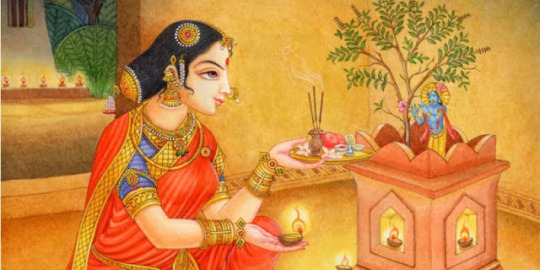
Vaishnavas traditionally use japa malas (a string of Hindu prayer beads) made from Tulsi

stems or roots called Tulsi malas, which are an important symbol of the initiation. Tulsi malas are considered to be auspicious for the wearer, and believed to connect him with Vishnu or Krishna and confer the protection of the deity. They are worn as a necklace or garland or held in the hand and used as a rosary. Tulsi's great connection with Vaishnavas is communicated with the fact that Vaishnavas are known as "those who bear the tulsi round the neck". Some pilgrims carry tulsi plants in their hands throughout their pilgrimage to Dwarka, the legendary capital of Krishna and one of the seven most sacred Hindu cities.
There are conflicting accounts about Tulsi leaves being used in the worship of the god Shiva, a rival sect (Shaiva) god to the Vaishnava Vishnu. While Bael leaves are often offered to Shiva, some authors note that Tulsi may also be offered to him. Tulsi worship is sometimes used in the worship of lord Shiva, conveying the deity's omnipresence. Shiva's aniconic symbol - the linga - is sometimes prescribed to have made from the black soil from the roots of the Tulsi plant. However, Tulsi is a taboo in worship of the Devi - the Hindu Divine Mother as the pungent aroma of the Tulsi plant angers her. It is also important for the worship of Hanuman. In Orissa, the Tulsi plant represents all local deities and rituals to propitiate them, are offered in front of the plant. The Nayars of Malabar offer Tulsi plants to pacify evil spirits
Festivals
A ceremony known as Tulsi Vivah is performed by the Hindus between Prabodhini Ekadashi (eleventh lunar day of the waxing moon of Kartika) to Kartik Poornima (full moon in Kartika), usually on the eleventh or the twelfth lunar day. It is the ceremonial wedding of the Tulasi plant to lord Vishnu. Both the bride and the groom are ritually worshiped and then married as per the traditional Hindu wedding rituals. It marks the end of the four-month Chaturmas period, which corresponds to the monsoons and is considered inauspicious for weddings and other rituals. This day thus inaugurates the annual marriage season in India.

Tulsi Vivah
In Orissa, on the first day of the Hindu month Vaishakha (April - May), a small vessel with a hole at its bottom is filled with water and suspended over the Tulasi plant with a steady stream of water, for the entire month. In this period, when a hot summer reigns, one who offers cool water to Tulasi or an umbrella to shelter it from the intense heat is believed to be cleansed of all sin. The stream of water also conveys wishes for a good monsoon.
Various Names of Tulsi in the Hindu Mythology
In the Hindu mythology, tulsi has been give various names. Some of them are :
Vaishnavi ("belonging to Vishnu")
Vishnu Vallabha ("beloved of Vishnu")
Haripriya ("beloved of Vishnu")
Vishnu Tulsi.
The Tulsi with green leaves is called Shri-Tulsi ("fortunate Tulsi"). Shri is also a synonym for Lakshmi, Vishnu's principal consort.
This variety is also known as Rama-Tulsi ("bright Tulsi"). Rama is also one of the principal avatars of Vishnu.
The Tulsi with dark green or purple leaves and purple stem is called Shyama-Tulsi ("dark Tulsi") or Krishna-Tulsi ("dark Tulsi"). Krishna is also a prominent avatar of Vishnu. This variety is considered especially sacred to Krishna, as its purple color is similar to Krishna's dark complexion.
Related Links
Every part of the Tulsi plant is revered and considered sacred. Even the soil around the plant is holy. According to the Padma Purana, a person who is cremated with Tulsi

twigs in his funeral pyre gains moksha and a place in Vishnu's abode Vaikuntha. If a Tulsi stick is used to burn a lamp for Vishnu, it is like offering the gods lakhs of lamps. If one makes a paste of dried Tulsi wood (from a plant that died naturally) and smears it over his body and worships Vishnu, it is worth several ordinary pujas and lakhs of Godan (donation of cows). Water mixed with the Tulsi leaves is given to the dying to raise their departing souls to heaven.
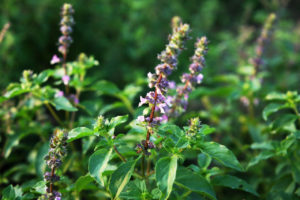
Just as Tulsi respect is rewarding, her contempt attracts the wrath of Lord Vishnu as well. Precautions have to be taken to avoid this. It is a taboo to urinate, excrete or throw waste water near the plant. Uprooting and cutting branches of the plant is prohibited. When the plant withers, the dry plant is immersed in a water body with due religious rites and rituals, as is the custom for broken divine images, which are unworthy for worship. Though Tulsi leaves are necessary for Hindu worship, there are strict rules for it. A prayer of forgiveness may also be offered to Tulsi before the act.
Yanmule sarvatirhaani Yannagre sarvadevataa
Yanmadhye sarvavedaascha Tulasi taam namaamyaham
I bow down to the tulasi, At whose base are all the holy places, At whose top reside all the deities and In whose middle are all the Vedas.
Basil and Ayurveda
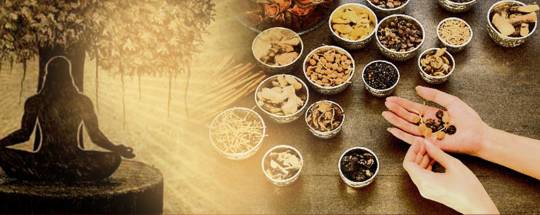
From prehistoric times the earliest inhabitants of the Indian subcontinent have held plants in great reverence. Nature was worshiped by India’s primitive tribes. According to the Hindu mythology the God of Death, Yama, himself gives way to the ‘holiness’ of the sacred Tulasi. However, India is unique and it has maintained this reverence right up to the present day. Tulasi, which was once worshiped as a plant with ‘magical powers’, was analysed by the Ayurvedic physicians for its physical properties as well. Tulasi is known as
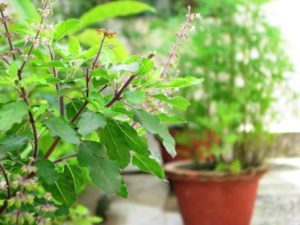
the Mother of Ayurveda. Basil has been used for thousands of years in Ayurveda for its diverse healing properties. It is mentioned in the Charaka Samhita, an ancient Ayurvedic text. Tulsi is considered to be an adaptogen, balancing different processes in the body, and helpful for adapting to stress. Marked by its strong aroma and astringent taste, it is regarded in Ayurveda as a kind of "elixir of life" and believed to promote longevity. It is an elixir for cough. the leaves when chewed after meals acts as a digestive, and when taken before and after cold water bath controls temperature in the stomach and prevents cold. If sprinkled over cooked food or in stored water, basil leaves prevent bacterial growth.Many Ayurvedic medicines are made from Tulasi and every part of her is useful.

Even the smell of Basil has a positive and soothing effect on the mind. In the early morning her leaves emit a type of oil. If you sprinkle water on her and then remain near her, preferably chanting a prayer or mantra, you will receive the benefit of this. Tulasi purifies the air day and night. Most plants take in oxygen during the night, but Tulasi gives out oxygen during both day and night, so you can keep her inside at night, especially when you are doing your japa, chanting and other sadhana.
Wherever the aroma of Tulasi is carried by the wind, it purifies the atmosphere and frees all animals from all baser tendencies.
~Padmapurana, Uttarakhanda
Read the full article
92 notes
·
View notes
Text
The Day of Shame
By Uri Avnery, CounterPunch, May 21, 2018
On Bloody Monday, when the number of Palestinian killed and wounded was rising by the hour, I asked myself: what would I have done if I had been a youngster of 15 in the Gaza Strip?
My answer was, without hesitation: I would have stood near the border fence and demonstrated, risking my life and limbs every minute.
How am I so sure?
Simple: I did the same when I was 15.
I was a member of the National Military Organization (the “Irgun”), an armed underground group labeled “terrorist”.
Palestine was at the time under British occupation (called “mandate”). In May 1939, the British enacted a law limiting the right of Jews to acquire land. I received an order to be at a certain time at a certain spot near the sea shore of Tel Aviv in order to take part in a demonstration. I was to wait for a trumpet signal.
The trumpet sounded and we started the march down Allenby Road, then the city’s main street. Near the main synagogue, somebody climbed the stairs and delivered an inflammatory speech. Then we marched on, to the end of the street, where the offices of the British administration were located. There we sang the national anthem, “Hatikvah”, while some adult members set fire to the offices.
Suddenly several lorries carrying British soldiers screeched to a halt, and a salvo of shots rang out. The British fired over our heads, and we ran away.
Remembering this event 79 years later, it crossed my mind that the boys of Gaza are greater heroes then we were then. They did not run away. They stood their ground for hours, while the death toll rose to 61 and the number of those wounded by live ammunition to some 1500, in addition to 1000 affected by gas.
On that day, most TV stations in Israel and abroad split their screen. On the right, the events in Gaza. On the left, the inauguration of the US Embassy in Jerusalem.
In the 136th year of the Zionist-Palestinian war, that split screen is the picture of reality: the celebration in Jerusalem and the bloodbath in Gaza. Not on two different planets, not in two different continents, but hardly an hour’s drive apart.
The celebration in Jerusalem started as a silly event. A bunch of suited males, inflated with self-importance, celebrating--what, exactly? The symbolic movement of an office from one town to another.
Jerusalem is a major bone of contention. Everybody knows that there will be no peace, not now, not ever, without a compromise there. For every Palestinian, every Arab, every Muslim throughout the world, it is unthinkable to give up Jerusalem. It is from there, according to Muslim tradition, that the Prophet Muhammad ascended to heaven, after tying his horse to the rock that is now the center of the holy places. After Mecca and Medina, Jerusalem is the third holiest place of Islam.
For the Jews, of course, Jerusalem means the place where, some 2000 years ago, there stood the temple built by King Herod, a cruel half-Jew. A remnant of an outer wall still stands there and is revered as the “Western Wall”. It used to be called the “Wailing Wall”, and is the holiest place of the Jews.
Statesmen have tried to square the circle and find a solution. The 1947 United Nations committee that decreed the partition of Palestine into an Arab and a Jewish state--a solution enthusiastically endorsed by the Jewish leadership--suggested separating Jerusalem from both states and constituting it as a separate unit within what was supposed to be in fact a kind of confederation.
The war of 1948 resulted in a divided city, the Eastern part was occupied by the Arab side (the Kingdom of Jordan) and the Western part became the capital of Israel. (My modest part was to fight in the battle for the road.)
No one liked the division of the city. So my friends and I devised a third solution, which by now has become a world consensus: keep the city united on the municipal level and divide it politically: the West as capital of the State of Israel, the East as capital of the State of Palestine. The leader of the local Palestinians, Faisal al-Husseini, the scion of a most distinguished local Palestinian family and the son of a national hero who was killed not far from my position in the same battle, endorsed this formula publicly. Yasser Arafat gave me his tacit consent.
If President Donald Trump had declared West Jerusalem the capital of Israel and moved his embassy there, almost nobody would have got excited. By omitting the word “West”, Trump ignited a fire. Perhaps without realizing what he was doing, and probably not giving a damn.
For me, the moving of the US embassy means nothing. It is a symbolic act that does not change reality. If and when peace does come, no one will care about some stupid act of a half-forgotten US president. Inshallah.
So there they were, this bunch of self-important nobodies, Israelis, Americans and those in-between, having their little festival, while rivers of blood were flowing in Gaza. Human beings were killed by the dozen and wounded by the thousand.
The ceremony started as a cynical meeting, which quickly became grotesque, and ended in being sinister. Nero fiddling while Rome was burning.
When the last hug was exchanged and the last compliment paid, Gaza remained what it was--a huge concentration camp with severely overcrowded hospitals, lacking medicines and food, drinkable water and electricity.
A ridiculous world-wide propaganda campaign was let loose to counter the world-wide condemnation. For example: the story that the terrorist Hamas had compelled the Gazans to go and demonstrate--as if anyone could be compelled to risk their life in a demonstration.
Or: the story that Hamas paid every demonstrator 50 dollars. Would you risk your life for 50 dollars? Would anybody?
Or: The soldiers had no choice but to kill them, because they were storming the border fence. Actually, no one did so--the huge concentration of Israeli army brigades would have easily prevented it without shooting.
Almost forgotten was a small news item from the days before: Hamas had discreetly offered a Hudna for ten years. A Hudna is a sacred armistice, never to be broken. The Crusaders, our remote predecessors, had many Hudnas with their Arab enemies during their 200-year stay here.
Israeli leaders immediately rejected the offer.
So why were the soldiers ordered to kill? It is the same logic that has animated countless occupation regimes throughout history: make the “natives” so afraid that they will give up. Alas, the results have almost always been the very opposite: the oppressed have become more hardened, more resolute. This is happening now.
Bloody Monday may well be seen in future as the day when the Palestinians regained their national pride, their will to stand up and fight for their independence.
Strangely, the next day--the main day of the planned protest, Naqba Day--only two demonstrators were killed. Israeli diplomats abroad, facing world-wide indignation, had probably sent home SOS messages. Clearly the Israeli army had changed its orders. Non-lethal means were used and sufficed.
My conscience does not allow me to conclude this without some self-criticism.
I would have expected that all of Israel’s renowned writers would publish a thundering joint condemnation while the shooting was still going on. It did not happen.
I would have expected that the dozens of our brave peace organizations would unite in a dramatic act of condemnation, an act that would arouse the world. It did not happen. Perhaps they were in a state of shock.
The next day, the excellent boys and girls of the peace groups demonstrated opposite the Likud office in Tel Aviv. Some 500 took part. Far, far from the hundreds of thousands who demonstrated some years ago against the price of cottage cheese.
In short: we did not do our duty. I accuse myself as much as I accuse everybody else.
But what topped everything was the huge machine of brain-washing that was set in motion. For many years I have not experienced anything like it.
Almost all the so-called “military correspondents” acted like army propaganda agents. Day by day they helped the army to spread lies and falsifications. The public had no alternative but to believe every word. Nobody told them otherwise.
The same is true for almost all other means of communication, program presenters, announcers and correspondents. They willingly became government liars. Probably many of them were ordered to do so by their bosses. Not a glorious chapter.
After the day of blood, when the army was faced with world condemnation and had to stop shooting (“only” killing two unarmed demonstrators) all Israeli media were united in declaring this a great Israeli victory.
Israel had to open the crossings and send food and medicines to Gaza. Egypt had to open its Gaza crossing and accept many hundreds of wounded for operations and other treatment.
The Day of Shame has passed. Until the next time.
1 note
·
View note
Text
Redefining The Meaning of Ramadan During an Outbreak of Coronavirus
When President Joko Widodo announced on 24th April that Indonesian Muslims should keep maintaining physical ditancing and staying at home during the month of Ramadhan, it’s clearly going to affect Ramadhan as well as changing how muslims define the holy month. Muslims has been tied to the customs of attending Iftar and communal prayers during the month. But without the social responsibility, it should have been easier for me as a Muslim to enhance and observe the meaning of Ramadhan, especially since I’m able to self-reflect, made the holiest month even more enriching for me.
Ramadan during the pandemic equals to not have the usual communal gathering in mosques, whether to have Iftar with family and friends, pray nightly taraweeh, to celebrating Eid as the mark of the ending for the holy month is too come with restrictions. Ramadan entails fasting daily from food, water, and marital relations from dawn to dusk which takes up approximately 13 hours for 29-30 days. In a country largely populated with Muslims, Indonesia’s cultural traditions have characterized the time as the month of socializing and dinner parties. As opposed to that, the main tenets of Islam emphasizes Ramadan as a month to increase persistence in faith and self-mastery to a level of extreme.
If there is one good thing the pandemic teaches us is that hygiene matters more than ever. For muslims, hygiene has been a part of practicing the religion on daily basis. As Prophet Muhammad said, “God is pure and loves purity,” which means that cleanliness is really important to maintain and performing “wudu” five times a day that includes washing hands, face, arms and feet, has long become the habit for us.
A part of the heritage of Islam is persistence when it comes to performing daily prayers. However, throughout generations, the very essence of Ramadan has slowly been fading away. It leaves muslims struggle in seeking for a profound connection to the sense of self and to the creator. Unfortunately, the lifestyle of today has subconsciously make Muslims frequently put aside their own needs, such as mental, physical, and spiritual needs, after the needs of others. During this pandemic, where we’re forced to stay at home and confronted with the same thing over and over again, it might make us try to redefine the struggle. It could simply be a matter of perspective to view this month as a reflective time, paying full attention to the state of being.
Instead of making ourselves busy with preparing food and arrange a so-called fancy and quality iftar with friends and colleagues, the focus of Ramadan should be about self-discipline and improving ourselves. During iftar, people tend to eat a large portion of food because of the abundance of food that’s available which oftentimes caused them to overeat. However, without having to attend the social obligations of hosting or attending iftars, food can be served in a proper portion, emphasizing the principle of Islam to eat sufficiently.
Islam teaches the importance of eating and drinking a little that we are adviced to allocate food to one third of the stomach, one third to water, and the last third for air. The act of wasting food and overeating are highly dissapproved. Moreover, the food that is being consumed must be “tayyib” and “halal”. Tayyib means that the food we’re eating must be clean and good for you. With Ramadan, it seems to fit the time to sort out the food we’re eating by making sure to stuff ourselves with healthy fresh food in smaller proportions.
The month of Ramadan also identical as the month of the Qur’an since it is the month when the Qur’an was revealed for the first time. For that reason, Muslims maximize their spending on time to reconnect with the Qur’an through doing as many recitations as one possibly can, even better to have finished reading the entire Quran. Going to the mosque for taraweeh prayer can be another way we can reflect by listening to the Imam reciting the entire Quran in the prayers over the month.
Ramadan during this time of physical distancing will be forcing Muslims to rekindle their spiritual relationship with God as well as Qur’an in a level more intense than usual. As it is also how Prophet Muhammad used to spend his time in Ramadan. He would spent time alone at a cave located in a top of mountain for 10 days only to reflect, introspect, worship and connect with God. It was always done during the last 10 days of Ramadan, the spiritual self-isolation is known to Muslims as “itikaf”.
The spirit of Ramadan, especially during this time lies on self improvement, self-discovery, self-discipline, and introspection. Even though the sense of community has taken away from us due to the pandemic that it impacts this crucial time so strongly, this in turn can be an ideal time to redefine what Ramadan means for Muslims.
Instead of regretting the spirit of Ramadan that’s different than usual, you should make the best out of this month by focusing on having a deep connection. Seek for an intimate connection with God through the act of going good deeds, prayer, and reflection. I encourage every Muslims to turn this month into a journey of self-reflection and perfecting one’s faith.
0 notes
Text
Varanasi: The Spiritual City Of India
Hello dear viewers, how are you all? What’s up these days? Missing those spiritual vibes on each occasion by not being able to go to your desired pilgrim place? If yes then i totally have a wonderful suggestion for you. The oldest pilgrim place and extremely spiritual with utter calmness, VARANASI.
Sunrise boat ride-
The holiest river- Ganges gives you enormous number of joyous moments one of which is witnessing the sunrise which is so serene. Soft pastel colors paint the sky as a few boats glide up and down the river. The cruise will float you past all of the different ghats , and also passing multiple temples along the way.
Blue lassi-
Blue Lassi is a hole-in-the-wall cafe, which celebrated its 75th birthday in 2015. It is super delicious at blue lassi than at any other cafe or street. They also have a large number of flavours where in you can choose your base; my personal suggestion would be chocolate, coffee and coconut. It is absolutely worth visiting.
Holy bath in the ganges-
This is one thing which almost every Indian craves for during their lifetime. It is said that when you take a bath in holy water of ganges, all your sins are washed and you can start over a new life where in you need to self introspect and make the most of this second chance. But a suggestion, kindly do not pollute the water (make sure you are clean when you go for bath in it), lets save this opportunity for our posterity too.
Mango smoothies-
The very delicious and famous mango smoothies,which are really affordable are worth trying in the streets of Varanasi. Fresh served with chunks of mango and papaya make it healthy too.
Ganga aarti-
Trust me this will actually be the best experience of your life if once in a lifetime you get the privilege to attend the ganga aarti which is performed every day at the banks of holy river. The large diyas and mesmerizing chants along with the evergreen spiritual vibe makes it most unique and a perfect thing to witness in Varanasi.
Explore temples-
The most popular temples out of 2000 are: kasha vishwanath and golden temple spread throughout the city. You can reach there by boats and even find guides for better understanding.
Walk along the ghats-
You will likely lose track of time as your senses are overwhelmed. There is so much raw action going on down at the ghats along The Ganges River. Herds of Buffalo are being washed by children in the river, groups of teenage boys are flexing in the river, intense cricket matches are getting loud, people are having their hair cut, boatmen try to coax people on board for a tour, massage and beard trims are left right and centre and people are in prayer.
Street shopping-
The city is widely known for silk sarees and ornate jewellery. The intricate pattern of floral designs and elaborate zari or thread work saris must be purchased from this beautiful place. One can also buy dazzling bangles, shawls, idols of hindu deities. The main shopping areas to explore in this city also include Vishwanath Lane, Thateri Bazaar, Chowk and Godowilia.
This was all about how magical and beautiful the oldest and continuously habited city in the world. Its ancient by-lanes and multicultural ethos makes for a colourful, chaotic. It is an interesting place to visit where many come to find god, spirituality or simply themselves is a gamut of life.
https://exploring2gether.com/varanasi/
0 notes
Text
%news%
New Post has been published on %http://paulbenedictsgeneralstore.com%
Bbc news Coronavirus: ¿podría Estados Unidos hacer lo que Italia ha hecho?

Bbc news
.spinner-container width:25%; top:20px; left:50%; margin-left:-12.5%; border-radius:8px; position:fixed; text-align:center; box-shadow:0 0 10px rgba(0,0,0,0.24); background:#fff; overflow:hidden; .spinner-container p font-family:'Roboto', Arial, sans-serif; color:rgba(0,0,0,0.87); margin:12px 0 16px 0; padding:0; font-size:12px; .spinner-container img width:22px; height:22px; margin:16px 0 0; padding:0;

Translating...
Image copyright Getty Photos
Image caption Also can a lockdown of Seattle ever happen?
As coronavirus sweeps at some stage within the US, American officials possess warned that important prevention measures may perchance presumably additionally be important to cease its spread. Nonetheless is the US keen to hotfoot as a long way as Italy - but every other democracy - and even authoritarian China?
Italy has banned mass gatherings and barred voters from travelling exterior of their home way.
China has forced better than 50 million voters to self-isolate and even threatened severe penalties, including death, for quarantine breakers.
So what measures is the US keen to take, and may perchance presumably coronavirus besiege an American city?
Bbc news Compelled lockdowns
Experts recount the US may perchance presumably one way or the opposite apply Italy's belief to quarantine a mountainous section of its inhabitants, but it undoubtedly would be very nice looking and would face out of the ordinary opposition.
"The chance of that taking place within the US is amazingly, extremely diminutive," says Dr Irwin Redlener, Director of Columbia University's National Centre for Catastrophe Preparedness.
"Genuinely that amounts to martial legislation," he tells BBC Data. "Executive ordered shutdowns" of public spaces and abilities to commute would be "a extremely a long way step for American citizens to reduction an eye on," he added.
"It be simply section of our culture. It be simply the antithesis of the freedoms that we theoretically possess."
Image copyright Getty Photos
Image caption Italian authorities review passengers' documents on the Milan put collectively problem
Dr Anthony Fauci of the US National Institutes of Health has said that "the rest is feasible" given the size of the outbreak, but mountainous scale quarantines attain no longer seem like on the horizon.
Because moderately few tests possess been conducted within the US, the correct scope of the grief is soundless unknown.
On Tuesday, Recent York's governor ordered a one-mile "containment zone" for the city of Recent Rochelle, about 20 miles (32km) from downtown Long island.
Companies interior the epicenter of the articulate's outbreak will dwell originate, but mountainous gathering spaces akin to community centres, colleges and homes of fancy will be closed. National Guards troops will be deployed to reduction to clean the shuttered amenities and carry meals to self-quarantining residents, who are free to leave the zone within the occasion that they desire.
"You're no longer containing folk," Gov Andrew Cuomo said. "You're containing amenities."
Bbc news Commute bans
Emergency managers are centered on particular person precautions, but they are also talking about the possibility of commute restrictions the same to Italy's, says Kyle McPhee, the Director of Preparedness Programmes for Hagerty Consulting, which specialises in catastrophe restoration and prevention.
In accordance with Mr McPhee, the emphasis now may perchance presumably be on "self-imposed quarantine or voluntary quarantine". It puts the burden "on the particular person and the overall public to protect themselves and their neighbours and their community safe," he says.

Media playback is unsupported on your instrument
Media captionMilan quarantine resident: "It be in actual fact crucial to be to blame in this 2nd"
Emergency planners make contingency plans in response to worst and handiest case eventualities, meaning that plans for forced quarantines are with out a doubt being discussed. Nonetheless Mr McPhee warned that mass closures may perchance presumably possess knock-on outcomes and it may perchance presumably be instant-sighted to enforce them in a creep.
Bbc news Public closures
Shall we recount, closing colleges may perchance presumably possess unintentional penalties within the US, says Dr Redlener.
"By closing colleges in poorer neighbourhoods, working fogeys must take off, they may perchance presumably additionally no longer earn compensation, and there's a colossal economic impact on them."
Unhappy households in most cases rely on US colleges to electrify breakfast and lunch to pupils, making it seemingly that younger folk would hotfoot hungry.
"These are no longer steps to be taken evenly" he says, adding that any quarantine measure will face "strenuous beautiful challenges, at every stage of govt" from civil rights groups.
The American Civil Liberties Union (ACLU) has revealed a letter signed by 450 public effectively being consultants acknowledging that "particular person rights must most frequently give strategy to the better beautiful" all over a plague.
Folks can most frequently be quarantined, for instance. "That is because it will soundless be" - as long as the measures are in response to scientific study proving effectiveness, says the neighborhood.
Image copyright Getty Photos
Image caption Pharmacies within the US are working low on cleaning presents and bottled water
Alternatively, voters must no longer lose their appropriate to grief the govts skill to protect them in captivity even though there may perchance be a quarantine, the neighborhood warns.
It also cautioned that containment zones may perchance presumably change into "politicised", for instance if the US govt tries to consume them to search out undocumented immigrants and deport them.
If migrants are timid to come ahead to ogle clinical remedy, the better community will be at better risk, the letter warns.
At closing, there are a long way extra gun-owners within the US than wherever else within the sector, as effectively as anti-govt factions that will presumably with out a doubt oppose govt intrusion in their lives.
Bbc news Law and remark
In the course of public effectively being emergencies native governments keep "emergency operation centres" to reduction an eye on the response, says Mr McPhee.
They are in most cases lead by the native effectively being company, which may perchance per chance presumably per chance take advice from consultants sooner than issuing quarantine orders.
The beautiful grief at US borders is a trend of and managed federally.
Below President Donald Trump, the federal govt has banned non-voters from coronavirus-hit regions entry, but US voters are allowed aid into the country after a two-week quarantine.
Local officials need extra aid from Washington, said Scott Gottlieb, the outdated Meals and Drug Administration (FDA) commissioner.
"There may perchance be no systematic belief of when a city ought to soundless end college, when they ought to soundless portray companies that they must telework, when they ought to soundless end movie theatres and cancel mountainous gatherings," he knowledgeable CBS info.
"We hotfoot away these decisions to native officials, but we in actual fact ought to soundless possess a comprehensive belief when it involves suggestions to cities."
Image copyright Getty Photos
Image caption Trump briefs the click on the US coronavirus response
Bbc news What about presents?
The governor of Washington articulate, the keep the majority of US deaths from Covid-19 possess happened, has said that officials are weighing "whether important measures are required".
Nonetheless closing events and public spaces "may perchance presumably be nice searching for the overall public because of they may perchance presumably additionally no longer possess considered the beefy wave but," Gov Jay Inslee said.
Washington has been receiving face masks and sanatorium gowns from the Strategic National Stockpile, the country's emergency clinical stash, but extra needs to be done by the federal govt to make emergency clinical presents accessible, Mr Inslee said.
The Strategic National Stockpile for the time being contains better than $7bn in clinical presents that will presumably be tapped within the tournament of an emergency. The US effectively being secretary has warned that it contains handiest a allotment of the face masks that clinical workers wish to protect safe while treating US sufferers.
Bbc news Releasing prisoners
Jail reform activists recount that these in jail are extra at risk of contract the virus due overcrowding and low ranges of sanitisation. The US jails extra of its voters per capita than any other country.
Inmates are quarantined from the rest of society, but no longer from every other. Activists warn that prisoners in most cases lack hand-washing amenities or hand sanitiser, which is on occasion deemed contraband due to its alcohol suppose.
Handcuffed folk may perchance presumably no longer quilt their mouths when they cough or sneeze.
Incarcerated inmates at some stage in Italy rioted when unusual restrictions had been announced on jail visits due to the virus, and Iran has temporarily released 70,000 prisoners to protect Covid-19 from spreading on the aid of bars.
In the US, Recent York Governor Andrew Cuomo announced that the articulate has hired prisoners to electrify approximately 100,000 gallons of hand sanitiser per week, but activists questioned whether or not they may perchance per chance be well-liked to undoubtedly consume the stuff.
Bbc news What are nations doing?
The UK is in "containment" mode, without a instant plans to cancel mountainous events
Saudi Arabia has banned pilgrims from visiting Mecca, the holiest position for the sector's 2bn Muslims
France has banned gatherings of over 1,000 folk
Eire has canceled St Patrick's Day parades
function gtElInit() var lib=new google.translate.TranslateService(); lib.setCheckVisibility(false); lib.translatePage('en', 'es', function (progress, done, error) if (progress==100 );
0 notes
Photo

12 Japanese Pharmacy Favorites
A little self-care goes a long way.
I’ve been in medical school for about three and a half years now and am always worried about the effects of academic and adulting demands on my health. As much as possible, I try to schedule in at least half an hour everyday for quiet time for myself- taking care of my skin, my mental health, and preparing for sleep- what little of it can be had, anyway.
It has also been a blessing to find a second family in Japan in these last few years and through them, learned innovative ways to care for these concerns- just by picking up the right products in the drugstore! I often get asked about what products I would recommend to friends visiting Japan, and figured after forever to finally sit down and write a short list of my favorites. These are some things I highly recommend you pick up next time you find yourself in the land of the rising sun:

1. Perfect Whip: I’ve used this cleanser for almost 3 years now, and believe it does a great job at keeping my skin clean. It’s called perfect whip for a good reason- you take a dollop of the cleanser and whip it up with a little water until it looks like heavy whipped cream. Not sure about the precise science, but I do feel like the whip consistency is so much gentler on the skin. Also in photo: Perfect Double Wash, which I plan to try after my whip stash runs out. Hope it’s a good alternative to double cleansing with multiple products.

2. COW Beauty Soap: I am very sensitive about scents in general, so when I find something that is subtle and not cloying but still smells clean, I stick to it. I was at a pharmacy in Chiba when I picked up my first blue box of Cow beauty soap. The Cow brand was founded in 1909 in Kyoshinsha, Japan, and has been an icon in Japanese hygiene since. It comes in two variants- rose (red box) and jasmine (blue box) and is loaded with great moisturizers like milk fat. This is the closest thing I’ve tried that makes your skin baby soft, and it’s at a great price point- only 108 yen.
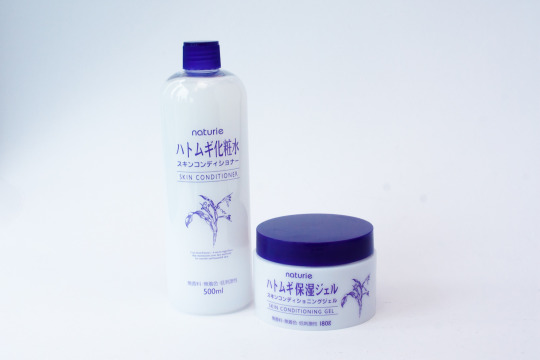
3. Naturie Skin Conditioner: I am constantly in pursuit of the perfect toner that wont dry my skin out. This Hatomuji Toner is made of pearl barley or job’s tears, which has long been used for medicinal purposes. I like that it has kept my skin breakout-free since I’ve started using it, and am excited to try the skin conditioning gel- reminds me a lot of all the new hydrogels on the market.

4. Biore UV Aqua Rich Watery Gel: My mom and grandmother both look at least a decade younger than they actually are, and what they both attribute to this is coconut oil and sunblock. So when I entered my 20s, I decided early prevention was best and embarked on the mission to find the perfect sunscreen. I’ve tried almost 20 brands over the years, but finally found my matches in the Biore UV Aqua Rich Watery Gel and Canmake Mermaid Skin Gel UV SPF 50 PA++++. I have probably gone through four bottles of this since I first tried the watery gel and wear it all over every single day, even when I’m just working from home. I love that it has the absolute lightest consistency, doesn’t leave a white cast, and is protective against UVA and UVB rays. Holiest of the holy grail in my beauty regimen.
5. Canmake Mermaid Skin Gel UV SPF 50 PA ++++. Unlike most sunscreens, this does not have alcohol in it, and for this reason it is what I use the most for my face. A little thicker than the Biore BUT much smoother in consistency, it is also light and leaves a nice dewy, glowy finish. This mermaid gel claims to have 85% of beneficial skin ingredients including hyaluronic acid, job’s tears, cherry leaf extract and other botanical extracts.

6. Shiseido Water in Lip Balm in Mint: I am the type of girl who keeps lip balm in every purse and the most intensively hydrating one by my bedside. I was using Vaseline’s lip treatment in Crème Brulee at night for a long time but was starting to get really annoyed with how greasy and tacky it left my lips in the morning. I bought the Water in Lip balm on my last trip to Japan and regretted immediately only having bought one. Intensely moisturizing, not greasy, and refreshing- my nightly regimen feels incomplete without reaching for this. Also makes for an excellent lipstick primer, especially when working with mattes.

7. KAO Megurhythm Steam Hot Eye Mask: I am the type of person who has a really hard time sleeping on planes. It’s usually because I’m cold intolerant and simultaneously always so excited to travel, so I can end up watching an entire season of a new show or six films on a long haul. That all changed when I found these MAGICAL eye masks. They’re paper mask that you unfold over your eyes that magically give the effect of a hot towel without the wetness. So wonderfully relaxing, I can’t travel without them anymore.
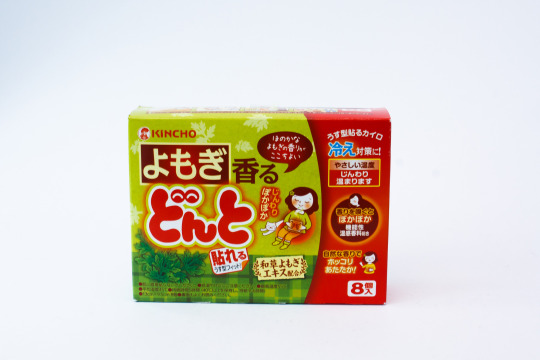
8. Kincho Heating Pads: The ultimate dysmenorrhea buster, ensuring pain-free days and the nicest warmth in the most discreet way. I usually go all-natural for rough red days (my lavender heating pillow is a godsend) but when I’m in school or need to be out for long periods with no access to a kettle or microwave, these have become absolutely essential.

9. Kyusoku Jikan Cooling Leg and Food Gel Pads: On my very first trip to Japan, I was so excited to sightsee Osaka that I walked a total of 32,000 steps in a day. Naturally I came home with swollen ankles and sore legs, and could barely walk the next morning. I mustered the strength to walk to the nearby convenience store that morning with every intention of buying painkillers, but found this aqua box with refreshed looking legs on the packaging. I bought these Kyousoku Jikan Cooling Leg Pads instead, slapped them on the back of my calves, and proceeded to walk another 18,000 steps that day.
It was like a miracle. Since then I always make sure to stock up on these. They’re incredibly effective- it’s like they suck the tiredness out of sore muscles. The Cooling Foot Gel Pads were a recent discovery on a trip to Tokyo. They work just like the leg pads, but have acupuncture points for the soles. Not going to lie, they feel like 100 tiny sharp points poking at your feet at the start (do not walk with them on), but they really do wonders for painful soles at the end of a long day.

10. Kinomegumi Natural Foot Detox Relax Sheet Pads in Lavender: In the spirit of transparency- I don’t really believe in Japanese detox foot pads, or at least that strapping a pad to the sole of your foot can really rid your body of toxins. I do believe though in the power of both temperature regulation and aromatherapy, so the lavender pads’ claim to help with stress really does work in my case. Whether it’s because I sleep better when warm and cozy or am really susceptible to the calming effects of lavender I will never know, but what I am sure of is that these really help me sleep.

11. Cough and Cold Warriors-Meiji Iodine Gargling Solution, Nazal Nasal Spray Pump, Nodonool Sore Throat Spray: Climate change in Manila is unkind to the allergy-prone, and can result in chronic sniffles. I personally am super atopic and have a ton of allergies, so I’ve learned to listen to my body and attack with preventive measures as soon as I can. Being a medstudent, I am also slowly realizing that it’s important to use medicine when really needed and according to prescribed use. So I am grateful to have found these more natural medicine cabinet staples that I really use at the onset of any attack of a cough or cold.

12. Ammeltz Yoko Yoko and Cura Heat Patches: In many ways I am a Tita, but in many ways I am also a little old lady. At the onset of any muscle aches or spasms, my family has learned to reach for our bottles of Ammeltz Yoko Yoko, which has become as integral to our homeopathic home health care as Arnica gel used for bruises. For days when we lift too much and our weakened rotator cuffs- all injured from a myriad of events- act up, the Cura Heat Patches are perfectly designed to cover all the spots where lamig or those nasty lactic acid deposits settle in.
All these can be bought in any Japanese pharmacy or drugstore. I’ve found that the best prices are at Don Quijote, Welcia Drugstore (Japan’s version of CVS, my personal favorite), or Matsumoto Kiyoshi. Avoid buying them at the airport or in tourist department stores as much as possible- prices tend to be significantly higher.
If you’ve made it to the end of this list, I hope you’ve found something new to try! Would also appreciate recommendations- what are your favorite Japanese health or beauty buys?
3 notes
·
View notes
Photo

New Post has been published on https://fitnesshealthyoga.com/13-important-indian-places-every-yogi-should-visit-india-yoga/
13 Important Indian Places Every Yogi Should Visit | India + Yoga
Rishikesh
Chandresh Bhardwaj
Trying to come up with the perfect itinerary to fit your time frame—and not sure where to start, given India’s vastness? Here, Chandresh Bhardwaj, author of Break the Norms, and a seventh-generation spiritual teacher in New York and Los Angeles who leads multiple retreats in his homeland of India each year, shares his top picks for the holy cities, historical sites, and spiritual pilgrimages every student of yoga should consider.
Contents
Holy Cities
Pilgrimages
Historical Sites
Important Places for Yoga
Thanks for watching!Visit Website
Holy Cities
Prayagraj
This lesser-known holy city, formerly called Allahabad and renamed in late 2018 by a new government trying to build a more spiritual India, is located at the confluence of the Ganges, the Yamuna, and the mythical Sarasvati Saraswati rivers. When the Kumbh Mela festival happens here (most recently in January 2019), it’s the largest: Up to 150 million pilgrims will travel from across the country and the world, and wait for days to bathe in the holy river.
See also Why Make a Yoga Pilgrimage?
Thanks for watching!Visit Website
Thanks for watching!Visit Website
Haridwar
The Ganges—or Ganga, considered a living goddess—descends from its source in the Himalayas, called Gomukh, to the north Indian plains in Haridwar before making its way across the country and pouring into the Bay of Bengal. That’s why this city’s name means “gateway to god” and has been a center of Hindu religion and mysticism since ancient times. In Hindu mythology, Haridwar is also one of the four sites where drops of amrit, the elixir of immortality, accidentally spilled over from the celestial bird Garuda’s pitcher. This manifested in the Kumbh Mela, a religious festival that’s celebrated four times over the course of 12 years at four different pilgrimage sites, including Haridwar. Even when this famous festival isn’t happening, you can experience nightly Ganga Aarti ceremonies here.
See also
Learn the History of the Ganges River with Kumbha Mela
Varanasi
Varanasi
One of the oldest inhabited cities on Earth, Varanasi is also one of India’s holiest. Walk on the river’s banks, and you’ll hear the near-constant clanging of puja ceremonial bells and see the flicker of lamps illuminating the holy river at night. You’ll also see pilgrims bathing—and a maze of funeral pyres, where bodies burn along Varanasi’s cremation ghat, or river bank. “This is a city where death is honored, welcomed, and celebrated in a sacred way,” Bhardwaj says. “Many Indians believe that if the right rituals are done at the time of their death, they’ll achieve the ultimate goal—liberation of the constant cycle of being born, suffering, and going through the drama of living—if their body is burned or their ashes are scattered in Varanasi.”
See also Find Your True Self in Rishikesh
Rishikesh
Want to practice in the footsteps of the ancient yogis? Rishikesh, considered by many to be the yoga capital of India—of the world, really—is where yoga, tantra, and mantras were created, Bhardwaj says. “There’s such powerful energy here that even if you don’t practice asana or meditation and just keep yourself receptive and open, big things can happen,” he says. On the banks of the holy river Ganges you’ll find ashrams, temples, and shops, as well as a diverse, international group of spiritual seekers. When you’re there, don’t miss Ganga Aarti, a fire ceremony at the sacred bank called Triveni Ghat.
See also Reflect + Renew in Rishikesh, India
Pilgrimages
Gomukh
The Ganges, also known as Ma Ganga, is the most revered, sacred river in Hindu lore. When Ma Ganga was asked to descend to Earth from the heavens, she was insulted, so she decided to sweep away everything in her path with her waters once she reached the terrestrial plain. In order to protect the Earth from Ma Ganga’s force, Lord Shiva sat in the Himalayan mountain town of Gangotri and caught the powerful river in his hair, saving the Earth from cracking open. Thanks to Shiva, Ma Ganga’s celestial, purifying waters then flowed through India, and the devout travel to her banks to wash away sins and find salvation. A multi-day trek to Gomukh—the Gangotri Glacier that is the site of Ma Ganga’s headwaters—is the ultimate pilgrimage, Bhardwaj says.
See also Yoga Journal’s Pilgrimage to India
Kedarnath
This north Indian town nestled in the Himalayas is where Lord Shiva is believed to have meditated. Pilgrims make the 11-mile uphill trek to the Kedarnath Temple—which, due to extreme weather conditions, is open only from the end of April to early November—to worship him. “Passionate yogis who meditate there for a while often experience intense energies,” Bhardwaj says.
Himachal Pradesh
Chandresh Bhardwaj
Himachal Pradesh
This northern Indian state in the foothills of the Himalayas is home to countless goddess temples and monasteries, Bhardwaj says, as well as the 14th Dalai Lama’s monastery, where he currently lives and gives public discourses. “It’s an especially interesting place because of the combination of Hindu and Buddhist traditions,” Bhardwaj says.
See also Pursuit of Happiness
Badrinath
Badrinath Temple, dedicated to Vishnu, one of the Hindu triad of gods along with Shiva and Brahma, is also one of the four Char Dham pilgrimage sites. Visiting the char dhams, which means “four abodes”—Badrinath, Dwarka, Puri, and Rameswaram—is something every Hindu must do during his or her lifetime, Bhardwaj says. “I think of Badrinath as the little brother of Kedarnath,” he says. “While Kedarnath is the homeland of Shiva, and has this intense energy as a result, Badrinath radiates a more holy, more Hindu energy.”
See also A Yogi’s Travel Guide to India
Historical Sites
Taj Mahal
Taj Mahal
One of the most recognized monuments in existence, this mausoleum is also one of the seven wonders of the world—and a must-see when making the trek to India. Located in Agra (part of India’s popular Golden Triangle circuit, which also includes Delhi and Jaipur), the marble monument was commissioned by Mughal Emperor Shah Jahan to house the tomb of his favorite wife, Mumtaz Mahal. It took 22 years and 20,000 workers to complete—and cost the equivalent of approximately $800 million today. While this UNESCO World Heritage Site will undoubtedly be crowded when you go (a whopping 7 to 8 million tourists visit each year), it’s well worth seeing.
See also 10 Destinations for Your Yoga Travel Bucket List
Pushkar
This town, located in the northeastern state of Rajasthan, is set on Pushkar Lake, a sacred Hindu site where pilgrims bathe along its ghats. It’s also home to the only temple of Brahma, the Hindu god known as the creator of the world, Bhardwaj says. “This is one of my all-time favorite places in India,” he says.
See also Kino MacGregor: India Is a Yoga Teacher
Hampi, Karnataka
The remains of more than 1,600 monuments are scattered over the 16-square-mile area of this UNESCO World Heritage site, which is the former capital of the Vijayanagar empire (in power from the 14th to 16th centuries). Amid the elegant ruins of medieval Indian culture, you’ll also find humbler shrines expressing the local villagers’ heartfelt devotion to Rama, Sita, and Hanuman. This area is the legendary Kishkinda, realm of the monkey gods, where Rama, one of the most widely worshipped Hindu deities, is said to have met the monkey god Hanuman on his quest to rescue his kidnapped wife, the goddess Sita.
See also 7 Ways to Stay Healthy While Traveling Through India
Important Places for Yoga
Mysore
Ashim D Silva
Mysore
Located in the southwestern state of Karnataka, this former capital of the Kingdom of Mysore is home to the opulent Mysore Palace and centuries-old Devaraja Market. Mysore was also home to Sri Tirumalai Krishnamacharya, an Indian yoga teacher, Ayurvedic healer, and scholar who’s often referred to as the father of modern yoga. Yoga students may know it as the birthplace of Ashtanga Yoga, where the Ashtanga Yoga Research Institute was established in 1948 and where Ashtanga practitioners from all over the world travel to practice and train.
See also 9 India Yoga Retreats That Will Change Your Life
Pune
B.K.S. Iyengar was born in 1918 in Bellur, a city that was in the grip of the influenza pandemic at the time. An attack left Iyengar sick throughout his childhood, and when he was 16 years old, his brother-in-law—Sri Tirumalai Krishnamacharya—asked him to come to Mysore to help with the family. There, Iyengar started to learn asana, which steadily helped his health improve. In 1936, Krishnamacharya sent Iyengar to Pune to spread the teaching of yoga. Now, Pune is home to the Ramamani Iyengar Memorial Yoga Institute—which Iyengar opened in 1975, and is considered the heart and soul of Iyengar Yoga. Iyengar students from all over the world come here to practice and train with the institute’s esteemed teachers.
See also 7 Things to Know Before You Book Your First Yoga Retreat
!function(f,b,e,v,n,t,s)if(f.fbq)return;n=f.fbq=function() n.callMethod? n.callMethod.apply(n,arguments):n.queue.push(arguments) ;if(!f._fbq)f._fbq=n; n.push=n;n.loaded=!0;n.version='2.0';n.queue=[];t=b.createElement(e);t.async=!0; t.src=v;s=b.getElementsByTagName(e)[0];s.parentNode.insertBefore(t,s)(window, document,'script','https://connect.facebook.net/en_US/fbevents.js'); (function() fbq('init', '1397247997268188'); fbq('track', 'PageView'); var contentId = 'ci024631b9300026e1'; if (contentId !== '') fbq('track', 'ViewContent', content_ids: [contentId], content_type: 'product'); )();
Source link
#balance#India Yoga Travel#Life#yoga exercises#yoga poses#Yoga Travel#Yoga Travel By Location#Yoga Exercises
0 notes
Photo

#Reflection Looking back there may seem to be mistakes and sins we’ve committed we may never be forgiven for. Even if, somehow, one is absolved by others, the shame of having committed them may cause such intense guilt that it turns to self-hatred, of feeling unworthy in the eyes of others. Yet, in front of the eyes of our Heavenly Father, we were and always will be naked. Our nature is sin, whilst Gods’ is forgiveness. We cannot hide our misdeeds from Him; we can only be forgiven in confessing them. Only if we have the courage to trust in the mercy of our Lord, in admitting to our darkest wrongs, can we be made pure again. #Prayer Merciful Father, who sees all that dwells within the heart, please wash my body of its scarlet sins, so that I may become pure as snow. Take my hand, and lead it to the Riverbanks of Jordon, wherein I may cleanse all my trespassings within the Holiest of waters. Bathe me in your mercy, so that I may emerge pure as a lamb, forever thankful, and forever in your debt. Amen. (at Robstown, Texas) https://www.instagram.com/p/Bz5jP7PB0h9/?igshid=eat5001x3zx6
0 notes
Text
An Indian assault course
If you were trying to design a week in India which aimed to scare off any visitor, it would most likely follow the path we took at the beginning of our second stay in India. A good old bout of Delhi belly aside, I think it’s fair to say we took everything India had to throw at us in our stride the first time around and came out in awe of the place. This next week proved to be a lot more challenging and it all began thanks to Tom’s second booking mishap, which featured an accidental 15 hour stopover in Chennai - all in the name of a cheap flight!
We arrived into Chennai at 5am and caught a taxi to a hotel, of sorts, not too far from the airport. They had kindly agreed to let us use a room for the duration of the day. In the darkness of the night, what we didn’t realise until we woke up slightly disorientated at 1pm, was that we had arrived in an area which felt less developed than the slum we had toured around in Mumbai! Even that had it’s trickle of tourists wanting to visit it! We ventured out to find some food and ate probably the only bad curry we had in India, from a takeaway kitchen which presumably serves other parts of the city with deliveries and wasn’t expecting sit down guests at lunchtime!

We just about got ourselves through the day and eventually arrived into Delhi late at night. Excited based on how much we had loved Mumbai, we were pretty much instantly hit by an ever present wave of disappointment, in the form of heavy air pollution which lingered in the air. Thanks to a tip from Joel & Alecia, we were staying in an area called Hauz Khas (or House of Cards as Harriet calls it) and this was the only real saving grace for Delhi in our eyes. It had a bit of a Berlin / Shoreditch does India feel to it and we enjoyed its liveliness and some great restaurants. And that’s about as far as the compliments for Delhi can go. Oh, the modern art gallery and national railway museum were two good ways to pass time when. Ok that’s all the best bits covered. Pollution aside (which is a pretty big ask to try and forget about) we just didn’t like Delhi. The people lacked the warmth we had encountered everywhere else. Someone tried to scam us when we got to the train station, which set the tone! The landmarks were busy and underwhelming. And when we thought we’d come up with a great way to forget about it - even our night at a jazz club turned into an absolute failure. We had our most expensive (and worst) meal in India there, which was a gluten free pizza, presumably gluten free as the base was seemingly made from cardboard. And any hope of the music saving the day was lost when a bumbling German walked on and started introducing his experimental sci-if jazz band, which we couldn’t hear for all the young Indian crowd who were clearly at the jazz club, just to tell people that they had been to the jazz club. It really was like a scene from the Fast Show jazz club. In hindsight we now find the whole thing very entertaining, but we definitely weren’t laughing at the time! To top it all off, we found out that one of our favourite DJs was playing on the night we left Delhi - and it was too late to rearrange our plans.

We’ve come to realise that so much of traveling is about expectations and that experiences can vary greatly, hinging on little more than chance. And due a bit of luck and not expecting much from our time in Agra (other than the Taj Mahal itself) we were pleasantly surprised. In fact you hopefully won’t have to hear too much more negativity from us again. Delhi definitely felt like the only low point we’ll remember. Arriving into Agra was a literal breath of fresh air. With a warm welcome, we were soon enjoying a late dinner on a rooftop which apparently overlooked the Taj Mahal. It was dark so we had to take his word for it then. We woke early, got near the front of the queue and excitedly entered the grounds, waiting for our first glimpse. During the winter months, there is a mist which rolls off the river behind the Taj and creates a truly atmospheric backdrop. As the sun warms the air, this mist dissipates to reveal the Taj in all it’s glory. With such high expectations, we were delighted that the Taj Mahal didn’t disappoint and we spent a couple of hours exploring this vast marble wonder and its beautiful grounds. Yes it was busy, but deservedly so. And once you’ve seen one riddiculous selfie pose here, you’ve seen them all - so we parked that in the back of our minds and just enjoyed it for what it was.


We had heard from a nice English couple that Agra fort was also worth a visit, so we headed there after breakfast and after a bit of uncertainty, we decided to take our first self-chosen tour guide of the trip. Going on nothing more than the outfit he was wearing, we felt like we might be in good hands. Tom’s first impression was that, a bit like Santhosh back in Alleppey, the guide, Kumar, is probably the type of guy who rides a Royal Enfield. We later found out that this strange hunch was infact true. Hiring Kumar turned out to be an excellent decision, as he really brought the place to life with tales of the Maharajahs who had lived there and the invasion attempts which had outlined it’s history. We decided to go along with his recommendation of a visit to an embroidery shop and again we’re pleased we did - they too had a fascinating history, displayed in a mini-museum of their own shop, including many orders from the British royal family and and some beautiful examples of work. Obviously we were also brought here as he works on a commission basis - so hopefully the Christmas tree decoration we purchased helped him out. Even if it was the cheapest thing in the shop! We spent the remainder of the day doing a bit of Christmas shopping for our families and relaxing on our hotels rooftop, which did indeed come complete with a view of the Taj Mahal. Reflecting on a short but sweet visit to Agra, we received a text update to inform us that our night train to Varanasi was running late. We didn’t realise at that point, that we’d end up getting into Varanasi nearly 7 hours behind schedule.

When it comes to the competition for India’s craziest place, Varanasi comes first, with daylight in second place. Our words alone won’t come close to describing everything that Varanasi encompasses, but in short, we’re glad we went, but definitely won’t be going back! It really is a place you’ve got to see to believe. Stepping out of the station felt like going back in time. Varanasi, built up on the banks of the river Ganges, is one of the oldest cities in the world and is regarded as the holiest of 7 sacred cities in Hinduism. The consequence of this, to put it bluntly, is that many Hindus come here to die. And cremations happen out in the open, as bodies are washed in the Ganges before families cremate them at the side of the river. It’s also seen to be good luck to shave your hair off before visiting Varanasi - but unlike many visiting Indians, we passed on this one! Dead bodies aside, Animals roam more freely than anywhere else we’d seen in India, in fact its the only place we had to jump out of the way of a bull beginning its charge. There were goats roaming everywhere and the overwhelmingly tame and loveable street dogs we’d grown accustomed to elsewhere, were visibly aggressive here. Oh and there’s lots of naked people who cover themselves in white paint and get angry if you encroach on their spot during the evening religious ceremony, a Varanasi must see.
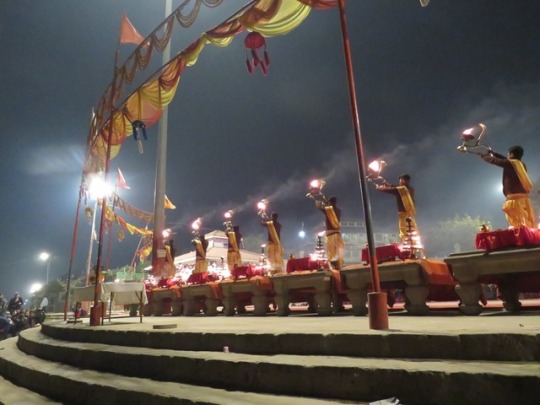

Our favourite experience was a sunrise boat trip, which was preceded by a religious ceremony which seemed to be a dress rehersal for the daily evening show we had already seen. Made particularly entertaining by our boat skipper who had skipped bed and come straight from a wedding, on this tour you get the best view of Varanasi’s many ghats (step baths into the river) where locals come to wash and brush their teeth in the same water that you can see families washing the bodies of their loved ones. That evening, back at our hostel, we got into a very interesting conversation about the ethics of photography, a particularly apt topic in a place like Varanasi. It was prompted after seeing a gaggle of tourists photographing a sleeping homeless man by the river and we were speaking to a travel photographer who often has to consider where ‘the line’ of acceptable photography is. We didn’t exactly reach a conclusion, but it’s a conversation which has been food for thought ever since, particularly when visiting remote towns or places with cultural traditions which feel a million miles away from ours and which need treating with sensitivity and respect.
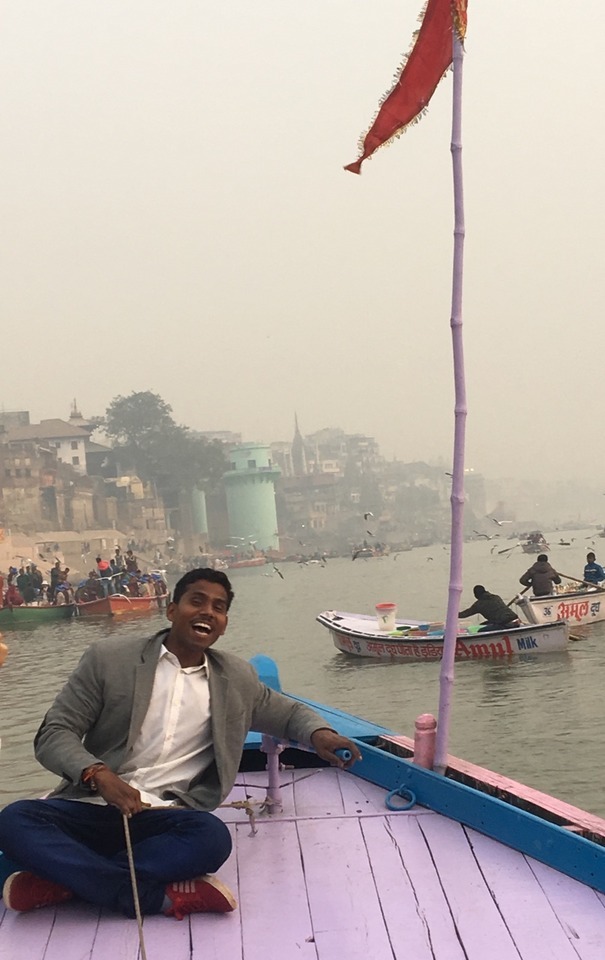
This stretch of India had undeniably tough parts and at times felt like a test of our love for this country. When we found out that our online ticket reservation to leave Varanasi had been unsuccessful (we won’t get into the complex ticketing system) we were faced with the prospect of having to unwillingly extend our stay in Varanasi. At the station we got talking to a couple from London who were on their honeymoon. They looked pretty shell shocked, having flown straight into Varanasi and now having similar problems with trains. But talking to them about their route through so many of the places we’d already been to and loved reminded us just how much India has to offer and how you’ve just got to take the rough with the smooth. It turns out Varanasi is notorious for train delays and an incredibly patient lady who was dealing with a never ending queue of tourists desperate to get out, eventually found us a solution from a relatively local train station. The good news was that we would be leaving later that evening, the bad news was that we had to go back to Delhi!
Food
It’s difficult to pin point exactly what the key differences were between Sri Lankan and Indian curries. We found Sri Lankan food to be much richer in flavour, whether that be down to Sri Lankan’s using more oil or coconut milk in their food or just due to the difference in spices from each country. Sri Lankan food was great but it did start to become quite an endurance towards the end. It’s safe to say we were really looking forward to eating Indian food again, we had really missed it.
Our first meal back in India kicked off to a pretty epic start at a wonderful restaurant, nestled amongst all the higgledy-piggledy buildings of Hauz Khas in Delhi, called Naivedyam. Naivedyam is the offering of food to god just before pooja begins. They quoted in the restaurant that “we in the hospitality business believe that the ‘consumer is god’” and that very much carried through to the whole experience and service of this meal. Even before ordering we were served a hot and spicy lentil drink called Rasam, some poppadoms accompanied with a fresh tomato chutney and a coriander chutney along with ice cold water served out of some very fancy silver jugs. Put it this way, it was like all the service and food ‘freebies’ of a Michelin starred meal at the cost of a boots meal deal.
Tom didn’t hesitate for a minute to order his absolute favourite, masala dosa. Harriet on the other hand went all out (shock) ordering a Naivedyam Tiffin Thali (basically an Indian breakfast thali), which included.....wait for it; a mini toppi dosa, rasam vadai, idly, umpa, curd rice, lemon rice, aloo subji samba, coconut chutney, tomato chutney, pakoda, pickle and kesri bhath (a sweet dish that Harriet may or may not have realised halfway through her meal). The food just kept coming and coming and being refilled if Harriet got anywhere close to finishing anything. Although triggering one hell of a food coma, it was a great fast track way to sample all of the traditional breakfast food, especially the bits we hadn’t already tried. One stand out had to be the rasam vadai, which was essentially like a small light and fluffy savory doughnut. Perfect for dipping in all of the wonderful array of chutneys. It was no surprise we squeezed in two more visits in our short stay in Delhi.

The next part of our trip involved A LOT of traveling on trains, meaning our diet pretty much consisted of chai teas. Tom even tried to make a desperate attempt to leg it onto the platform to get in a cheeky round, only to find the train was moving when it was his turn to be served. Much to Harriet’s relief the desire for chai was overruled by the prospect of being split up in the middle of nowhere India.
Another highlight for the “first leg of the second part of our trip to India” was the dosa cafe in Varanasi (shout out to Alecia and Joel for the recommendation). The restaurant was so small you were made to cram together and share tables with fellow diners. We were sat with a Russian “hard core” traveller it would seem who was shocked that we were only spending 2 months in India. We felt we had to excuse ourselves for having lives to get back to after this trip. Luckily a cow trying to enter the restaurant broke the ice and she warmed up a little.

However, back to dosas, and every type of dosa you could imagine with more variety of fillings we had ever come across. But the real star of the show had to be the chocolate fudge idly served with ice cream. Basically it was the gooiest, sweetest delight of a pudding that was even more of a treat because the base ingredient was rice so Tom could enjoy every last mouthful.
Travel Jukebox - ‘Teen Dream’ by Beach House
For the second week in a row, we had an album from an artist that we had never heard of to look forward to. This time it was from Tom’s big sis, Jo, who has an excellent track record of filtering down musical discoveries and is largely responsible for turning Tom into a music snob from an early age. Jo and Nick enjoyed their own adventure in ‘the East’ several years ago at a similar life stage and it was this album which apparently soundtracked much of their trip.
The album has been a real grower, which may not sound like a compliment but it really is when it turns into an earworm of an album. It starts very strongly with ‘Zebra’ and ‘Silver Soul’ both tracks which sound so familar, despite not recognising Beach House. On first listening, maybe it was the wrong mood, maybe it was the long, hot bus journey with a driver who thought he was Lewis Hamilton, but much of the rest of the album seemed to mould into one. But with further listenings, of which there have now been many, each track has really grown on us and familiarity has given this album a real warmth, making it easy to see how it became an album to soundtrack a trip.
Beach House describe themselves as a Dream Pop duo, which explains better than we could, why their music seems so apt for traveling. In fact, this was exactly the type of album which made us realise just how difficult it is to write about music, when sometimes there’s not much more to say than it put a smile on our faces and stuck with us and there’s a good chance you’ll like it too!
TLDR; We thought Mumbai was the deep end, but that’s the baby pool compared to Varanasi..!
0 notes
Text
Potential Post-Coronavirus Geo-economic Shifts

By James M. Dorsey
A podcast version of this story is available on Soundcloud, Itunes, Spotify, Stitcher, TuneIn, Spreaker, Pocket Casts, Tumblr, Podbean, Audecibel, Patreon and Castbox.
New York governor Andrew Cuomo has become the articulate, compassionate political face of government competence in fighting a pandemic.
That’s quite an achievement for a man who as late as early March 2020 trumpeted: “Excuse our arrogance as New Yorkers… We think we have the best healthcare system on the planet right here in New York. So, when you’re saying what happened in other countries versus what happened here, we don’t even think it’s going to be as bad as it was in other countries. We are fully coordinated; we are fully mobilized.”
New York was neither fully coordinated, nor was it fully mobilized.
In fact, it became the pandemic’s prime hotspot in the United States, accounting for the highest number of infection cases and the highest mortality rate. Its hospitals were overwhelmed, its stockpiles depleted, its frontline workers perilously exposed to risk of contagion. Many of the deaths could have been prevented had Mr. Cuomo opted to lock down the Big Apple earlier.
For now, that recent history has largely been forgotten. Mr. Cuomo thrives in his element, a rising star on America’s political ferment. His sober but empathetic, fact-based daily briefings project him as a man in command with a mission to ensure the health, safety, and wellbeing of his state.
If Mr. Cuomo, a veteran of dealing with the aftermaths of disasters like Hurricane Sandy, learnt anything from his delayed response to the coronavirus pandemic, it was that “an outbreak anywhere is an outbreak everywhere.”
Unlike other epidemics in recent years such as the Severe Acute Respiratory Syndrome or SARS in the early 2000s, the Middle East Respiratory Syndrome (MERS) in 2012 or the eruption of Ebola in West Africa in 2014, the coronavirus, dubbed COVID-19, left no corner of the globe untouched.
It is a lesson that goes to the heart of all that is wrong with global, regional, and national healthcare governance. It is a lesson that calls into question social and economic policies that have shaped the world for decades irrespective of political system.
It is also a lesson that goes to the core of the relationship between government and the people. It positions social trust as a pillar of an effective healthcare policy in a time of crisis.
In an era of defiance and dissent as a result of a breakdown in confidence in political systems and political leadership that kicked off with Occupy Wall Street and the 2011 Arab popular revolts and led to the rise of populists, mass anti-government demonstrations and in 2019 the toppling of leaders in Algeria, Sudan, Lebanon and Iraq, lack of trust complicated government efforts to counter the virus.
Distrust persuaded many Iranians to initially refuse to heed public health warnings to maintain social distancing, stay at home and install an Android app designed to help people self-diagnose and avoid rushing to hospital.
Pakistanis put their faith in religious leaders who rejected government demands for a halt to congregational prayers. So did many Russians as bans on mass gatherings split the clergy and threatened to undermine the Russian Orthodox Church’s key support for President Vladimir Putin.
Post-mortems of governments’ handling of the crisis once the coronavirus has been contained could increase the trust deficit.
Moreover, in an indication of pent-up anger and frustration that could explode, the imposition of curfews and stay-at-home orders failed to prevent incidental outbursts, including protests in mid-American states, quarantined Egyptian villages and poorer Tunisian and Moroccan hamlets.
In an echo of the Tunisian vendor who sparked the 2011 Arab revolts, 32-year-old unemployed and physically disabled Hammadi Chalbi set himself alight in a town 160 kilometres southwest of Tunis after authorities’ refused to license him as a fruit seller. In Lebanon, a taxi driver set his vehicle on fire while fruit vendors dumped their goods in the streets in expressions of mounting discontent. The protests suggest a universal corollary with the pandemic: an outbreak anywhere is an outbreak everywhere.
Protesters in 2019 went beyond demanding the fall of a leader. They sought the fall of political elites and radical overhaul of failed political systems. The pandemic called an abrupt halt to the protests. Protesters like the rest of the population went into temporary hibernation.
When they re-emerge, they are likely to put government leaders who prioritized political advantage above their health and economical well-being at a cost that surpasses that of the 1929 Great Depression on par with crimes committed against humanity during times of war.
Social, economic, ethnic, and sectarian fault lines are likely to be hardened in countries like Pakistan and Iraq where militants stepped in with healthcare and other social services to fill voids created by lack of government capacity.
The pandemic further painfully illustrated the economic cost of not only failing to confront a health crisis in a timely fashion but also the risk inherent in policies that do not ensure proper healthcare infrastructure in every corner of the globe, guarantee equal access to healthcare, make sure that people irrespective of income have proper housing and nutrition, turn a blind eye to the destruction of healthcare facilities in conflict situations like Syria, Yemen, Libya, Ukraine, Nagorno-Karabakh, Myanmar, and the Democratic Republic of Congo, tolerate millions of refugees existing in sub-standard living and hygiene conditions, and disregard environmental degradation and climate change.
The pandemic casts a spotlight on the deprivation of populations of proper healthcare as a result of politically motivated discriminatory social and economic policies.
The non-discriminatory nature of the coronavirus forced the Israeli government to ramp up testing in communities of Israeli Palestinians which had been described by public health experts as a ticking time bomb.
The experts warned that Israeli Palestinians, who figured prominently among frontline doctors and nurses treating Jews and Palestinians alike, were an at-risk group, many of whom suffer from chronic diseases, live in crowded conditions, and are socially and economically disadvantaged.
Ramping up testing to prevent the spread of COVID-19 constitutes an immediate effort to stem the tide but does little to structurally prepare Israeli and Palestinian society for the next pandemic.
Pre-dominantly Palestinian “East Jerusalem is gravely neglected in every possible way in terms of the infrastructure. Most neighbourhoods of East Jerusalem don’t have sewage systems. Just about every possible public service you can think of is underbudgeted and lacking in East Jerusalem. The only thing they get a lot of is parking fines and (punitive) housing demolition orders, said” left-wing member of the Jerusalem municipal council Laura Wharton.
A Monopoly board centred on Jerusalem given to her by Moshe Lion, the city’s mayor and a former economic advisor and director general of prime minister Benyamin Netanyahu’s office, illustrates the political calculus that potentially puts not only Jews and Palestinians but populations elsewhere at risk in a future pandemic.
“You have here the City of David, the Mount of Olives, the Knesset (the Israeli parliament), the Montefiore windmill, the markets, (the ultra-orthodox Jewish neighbourhood of) Mea She’arim. Al Aqsa (the third holiest Muslim site) is not here, the Church of the Holy Sepulchre is not here. Basically what you have is a bunch of Jewish sites and various illusions to other things. It’s not a very balanced picture of Jerusalem,” Ms. Wharton noted pointing at various landmarks on the board.
African Americans, Hispanics and native Americans tell the story, They have fallen disproportionately victim in the United States to the coronavirus.
US surgeon general Dr. Jerome Adams, a 45-year old African American vice admiral in the U.S. Public Health Service Commissioned Corps, one of America’s eight uniformed services, pulled out his inhaler at a White House press briefing in April 2020, saying he's carried it around for 40 years, "out of fear of having a fatal asthma attack."
Looking fit and trim in his dark uniform, Mr. Adams said he also had a heart condition and high blood pressure. "I represent that legacy of growing up poor and black in America. And I, and many black Americans, are at higher risk for COVID."
The surgeon general said that “its alarming but not surprising that people of colour have a greater burden of chronic health conditions. African Americans and native Americans develop high blood pressure at much younger ages… and (the virus) does greater harm to their organs. Puerto Ricans have higher rates of asthma and black boys are three times (more) likely to die of asthma than their white counterparts…. People of colour are more likely to live in densely packed areas and multi-generational housing, situations which create higher risk for the spread of a highly contagious disease like COVID-19. We tell people to wash their hands, but a study shows that 30 percent of homes of the Navajo nation don’t have running water, so how are they going to do that?”
What goes for one of the wealthiest nations on earth goes for the rest of the world too, particularly with the last two decades suggesting that pandemics occur more frequently and are likely to do so going forward.
What started in Wuhan in China in December 2019 had by April 2020 brought the world to a virtual standstill. Millions across the globe were infected, tens of thousands did not survive, economies shut down and the prospects for recovery and return to what was normal seemed a mere hope in a distant future.
Andrew Cuomo may be the exception that confirms the rule. There is little in the response of leaders from China’s Xi Jingping to Russia’s Vladimir Putin, Turkey’s Recep Tayyip Erdogan and US President Donald J. Trump that suggests that the lesson that an outbreak anywhere is an outbreak everywhere has persuaded them to think in terms of structural change.
If the first six months of the coronavirus are anything to go by, the name of the game has been jockeying for political positions, ideology trumps science, and everyone for him or herself in a race to the bottom rather than apolitical banding together globally, regionally and nationally to fight a dangerous and debilitating common enemy.
The response to the pandemic reflected the crumbling of the post-World War Two international order that is in the grips of a struggle by big and medium-sized powers to shape global governance in the 21st century.
The struggle has already crippled the United Nations and politicization of the coronavirus and healthcare threatens to undermine the World Health Organization, the one, albeit flawed, structure capable of coordinating a global response.
Complicating the response, was the rise of civilizationalists like Mr. Xi, Indian prime minister Narendra Modi, Hungarian prime minister Victor Orban and Mr. Trump who think in civilizational rather than national terms.
They conceive of their nations as civilizations in which Hans, Hindus or Christians rule supreme and there is no equal place for minorities rather than nation states defined by legally recognized borders, population, and language.
Theirs is a world of neglect for international law, increased conflict, political violence, and mass migration that promises to be even less prepared for the next pandemic. It is also a world in which early warning systems are weakened by muzzling of a free press.
Former US president Barak Obama, in his opening blast against Trump in the run-up to the November presidential election, put his finger on the pulse.
“What we are fighting against is these long-term trends in which being selfish, being tribal, being divided and seeing others an enemy, that that has become a stronger impulse in American life. And by the way, you know, we are seeing that internationally as well. And it’s part of the reason why the response to this global crisis has been so anaemic and spotty… It has been an absolute chaotic disaster when that mindset of what’s in it for me and to heck with everybody else – when that mindset is operationalized in our government,” Mr. Obama told a virtual gathering of his former staffers.
The pandemic demonstrates the need for coordinated policies ranging from global, regional, and national stock piling, international cooperation in medical research and development, conflict mediation, protection of minority rights, environment, absorption of refugees and robust but diversified supply chains.
It also highlights the importance to healthcare of eradication of poverty and proper social security nets, housing, hygiene, and access to water in a world in which an outbreak anywhere is an outbreak everywhere.
The pandemic positions an approach towards healthcare that is integrated into sustainable social and economic policies as a matter of global and national security on par with regional and national defense and security policies and investments.
It also raises the question of what role major non-governmental institutions like the Clinton Initiative, George Soros and the Gates Foundation can play.
Dr. James M. Dorsey is an award-winning journalist and a senior fellow at Nanyang Technological University’s S. Rajaratnam School of International Studies in Singapore. He is also an adjunct senior research fellow at the National University of Singapore’s Middle East Institute and co-director of the University of Wuerzburg’s Institute of Fan Culture in Germany
#United States#Trump#pandemic#coronavirus#coronavid19#covid2019#Russia#health#refugees#china#iran#pakistan#Israel#middle east
0 notes